.
THE CARRIAGES
at Shelburne Museum
By Lilian Baker Carlisle

Museum Pamphlet Series, Number 1
PUBLISHED BY
THE SHELBURNE MUSEUM
SHELBURNE · VERMONT
COPYRIGHT 1956
BY THE SHELBURNE MUSEUM, INC.
SHELBURNE, VERMONT
PRINTED IN THE UNITED STATES OF AMERICA
BY THE LANE PRESS, BURLINGTON, VERMONT
[iii]
Can You Remember ...
In the 1900 United States census, there were listed 4,571 vehicle-constructing concerns. They employed 126,000 men and paid yearly wages to the amount of $70,000,000. Fifty years later one or two specialists still manufacture a limited variety of vehicles, but during our lifetime the carriage trade has vanished.
Persons now living rarely conceive of themselves as a part of history and seldom make provisions for the perpetuation of examples and data of their era. Although most of the carriages that once crowded the roads have disappeared, some fine examples still exist in America on large estates in hay-filled barns and dusty carriage houses, and it is to be hoped that these few remaining vehicles will be rescued and placed in museums where they will be preserved for the generations that come after us as living mementoes of our past. Even the printed material, old carriage maker’s catalogues, plans, illustrated magazines, scrapbooks, wall charts, technical and account books—once present in every carriage maker’s shop, has all but disappeared. This material is of great value to the researcher, librarian and curator at museums which have made provisions for its preservation. Persons owning any of these documents would be performing an act of public service in offering this material to museums, libraries or historical societies so that it too can be kept intact.
The collection of vehicles at the Shelburne Museum contains the sleighs and carriages, light and heavy, formerly owned by the late Dr. and Mrs. W. Seward Webb; also those given by Mrs. Richard V. N. Gambrill in memory of her husband; gifts of single carriages or sleighs from interested donors; and purchases made to secure representative vehicles. Illustrated in this pamphlet, which is the first of the Shelburne Museum series, are examples of many of the carriage types on display. A complete listing of the other carriages will be found on page 65. A later publication will depict and describe the farm and commercial wagons, as well as the fine collection of sleighs.
“Setting up” a fine carriage in the last century was quite different from purchasing a fine automobile today. Considerable knowledge was required as to style of harness, liveries, purpose, details and customs. The description of one of the most costly late 19th century stables here in the United States reads like a tale from the Arabian nights. The town coach barn of this owner contained a coach, a brougham, a hansom, a runabout and an opera wagon, but the carriage house at his country estate was awe-inspiring. It sheltered[iv] dozens of vehicles of every sort, and a corps of stablemen was employed to maintain these vehicles in first class condition. In 1905 this collection was broken up and auctioned off to the hundreds who came and went during the days of the sale. Newspaper accounts of the day said that they were bewildered by the display of the victorias, the park drags, the skeleton breaks, the two hundred sets of harness, the magnificent monogrammed blankets for the horses and all the rest of the accoutrements.

SKETCHED FROM LIFE BY T. WORTH LITH CURRIER & IVES, N. Y.
ENTERED ACCORDING TO ACT OF CONGRESS IN THE YEAR 1869 BY CURRIER & IVES IN THE CLERK’S OFFICE OF THE DISTRICT COURT OF THE U.S. FOR THE SOUTHERN DISTRICT OF NEW YORK
FASHIONABLE “TURN-OUTS” IN CENTRAL PARK.
NEW YORK PUBLISHED BY CURRIER & IVES 152 NASSAU STREET
The “carriage parade” was a daily event in every major American city and New York’s vehicles thronged over the ten miles of fine carriage roads in and around Central Park. Every afternoon between the hours of four and five, fashionable society of New York “took the air.” East Drive from the Mall south to Fifth Avenue and 59th Street was lined with spectators, and in their polished carriages, attended by their immaculate servants, the élite drove back and forth, passing and re-passing each other. It is said that the first time they met each other, they bowed ceremoniously, the second time they smiled, and the third time they looked away. When warm weather came, society moved out of the city en masse, and their[v] carriages went along too. The summer carriage parade at Newport, Rhode Island was reputed to be even finer and more glittering than the New York “promenade on wheels.”
In the United States, it was not only the people of wealth and fashion who owned carriages, and herein lies one of the great differences in our attitude and that of the countries abroad. We developed the rockaway, surrey, buggy and buckboard; vehicles that could be produced inexpensively; vehicles that were light and practical with a stripped-down functional look, yet for all their air of fragility, possessed of great strength. We fashioned them so that a servant was not required either to drive them or to maintain them; we built them in such numbers and so well that the treatise on Coachbuilding published in London in 1881 by J. W. Burgess noted:
“The carriages of America are so different from our own and from those of Europe that they require special attention. It is quite possible that in the future their style may greatly influence carriages in all parts. The first noticeable trait in them is lightness.... Americans have adopted some of the shapes of Europe and the European mode on constructing the under-carriages, retaining their own method of making the pole and splinters, as giving greater freedom to the horses.
“The cheapness (of their vehicles) is attained by making large numbers to the same pattern, by the use of (machinery) and by the educated dexterity of the American workman, always ready to adopt any improvement.”
Horse-drawn vehicles have played a vital part in the lives of civilized peoples, and that period cannot pass for long without demanding the attention of research scholars whose basic interest is to record activities of the past for the benefit of the future.
Mr. and Mrs. J. Watson Webb, founders of the Shelburne Museum, have assembled this collection of vehicles and placed it on display in the hopes that it will play a part toward preserving for posterity the examples of the coachbuilder’s art during the 19th and early 20th centuries.
Lilian Baker Carlisle
Shelburne, Vermont.
April 1, 1956
Table of Contents
| PAGE | |
|---|---|
| Introduction | iii |
| Carriages for an Owner’s Driving | |
| Mail Phaeton | 1 |
| Spider Phaeton | 2 |
| Cut-under Phaeton | 3 |
| George IV Phaeton | 4 |
| Basket Phaeton | 6 |
| Miniature Phaeton | 7 |
| Curricle | 8 |
| Chaise | 9 |
| Doctor’s Gig | 10 |
| Dog Cart | 11 |
| Tandem Cart | 12 |
| “Going-to-Cover” Cart | 14 |
| Shooting Cart | 15 |
| Non-Sporting Carriages | |
| Brougham | 16 |
| Landau | 18 |
| Panel-boot Victoria | 19 |
| Skeleton-boot Victoria | 20 |
| Vis-à-Vis | 22 |
| Private Omnibus | 23 |
| Calèche | 24 |
| Berlin | 26 |
| Carroll Coach | 28 |
| Formal Coach | 29 |
| Irish Jaunting Car | 30 |
| Hansom Cab | 31 |
| Coaching and Other Four-In-Hand Vehicles | |
| Road Coach “Liberty” | 32 |
| Park Drag | 34 |
| Road Coach “Defiance” | 36 |
| Skeleton Break | 37 |
| Body Break with Perch | 38 |
| Carriages of American Origin | |
| Three-seat Surrey | 40 |
| Extension-top Surrey | 41 |
| Depot Wagon | 42 |
| Coupé Rockaway | 43 |
| Six-passenger Rockaway | 44 |
| Buckboard Phaeton | 45 |
| Pony Buckboard | 46 |
| Double Buckboard | 48 |
| Triple Buckboard | 49 |
| Unclassified Vehicles | |
| Racing Sulky | 50 |
| Skeleton Wagon | 51 |
| Tub Cart | 52 |
| Kentucky Breaking Cart | 54 |
| Concord Wagon | 55 |
| Pleasure Wagon | 56 |
| Canadian Calèche | 57 |
| Mountain Wagon | 58 |
| Barge | 59 |
| Schroon Lake Concord Coach | 60 |
| Concord Mud Wagon | 62 |
| Highland & Alpine House Concord Coach | 63 |
| Bibliography | 64 |
| Catalog | 65 |

HORSESHOE BARN
This barn was the first structure erected on the Shelburne Museum grounds. Copied from a barn located in the northern part of Vermont, it was built of timbers from eleven different old Vermont barns and two grist mills. It now houses the collection of carriages and is the only building on the grounds that is not a preservation.
Each of the other twenty-four structures located on the twenty-five acres has been chosen for its individual beauty or interest. Although the buildings have been restored architecturally, they now serve as the background for the lifetime collections of the founders and it is only in the five homes that contemporary household furnishings have been displayed.
Shelburne Museum is essentially a “collection of collections” and is one of the newest of the outdoor country museums. It was founded in 1947 by Mr. and Mrs. J. Watson Webb, and has been chartered by the State of Vermont as a non-profit educational institution.
Located on Route 7, just seven miles south of Burlington, Vermont, the Shelburne Museum is open each year from May 15th to October 15th.
[1]
CARRIAGES FOR AN OWNER’S DRIVING

MAIL PHAETON
Dark green; cane work at back of seat. Trimmed in eggshell broadcloth.
Styles in carriages, like women’s fashions, changed continuously. Speaking of the mail phaeton, a massive, masculine pair-horse carriage, the Duke of Beaufort in 1899 said: “They are much in use by noblemen and gentlemen and frequently employed by bachelors for long posting journeys in England as well as the Continent. They have almost reached perfection in the hands of the builder, Peters.”
Just fourteen years later, Francis M. Ware wrote: “In phaetons, the cumbrous and lumbering mail phaeton is as extinct as the dodo.”
The mail phaeton took its name from the mail coach and was characterized by its wooden perch (the pole running from the rear to the front axle) and mail coach springing. In England, these vehicles were used to send out mail and parcels to the nearest point where the royal mail coach passed.
Gift of the Webb family in memory of Dr. and Mrs. W. Seward Webb
[2]

SPIDER PHAETON
Black with red; canework at back of seat. Trimmed in blue broadcloth.
In 1888, G. N. Hooper (feature writer for Driving magazine) wrote: “For some years the young men of fashion have driven a small Stanhope phaeton. They are now giving place to spider phaetons, a sort of Tilbury body on four wheels, with a neat little seat for the groom behind, supported on branched irons; most of them have a folding head over the front body.
“Those first made had a trembling and vibrating motion; but with more solid construction ... they have become not only comfortable, but with more refined designs and construction, more stylish in appearance. They carry a lady and gentleman on the front seat comfortably, and the hind seat is made of such size as to carry only one person, and the groom runs no chance of having his dignity hurt by his master or one of his friends having to sit beside him.”
This spider phaeton was built in Paris, France by Muhlbacher.
Gift of Mrs. Gambrill in memory of her husband, Mr. Richard V. N. Gambrill
[3]
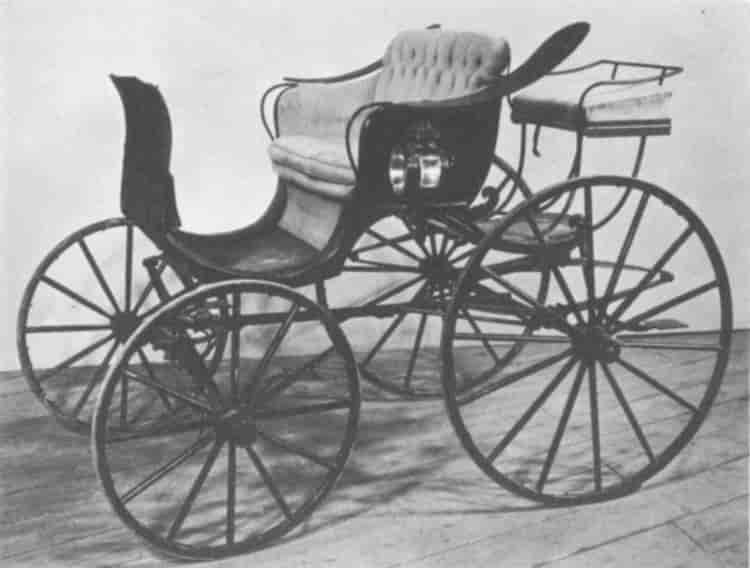
CUT-UNDER PHAETON
Body painted dark green. Trimmed in tan whipcord.
A wide variety of carriages are known as phaetons, but usually the name is given to an open vehicle with four wheels which is intended for personal driving by the owner.
The name phaeton comes to us from classical mythology. Helios, the sun god, had a son called Phaet(h)on who in attempting to drive the sun chariot through the sky lost control of the horses and lest he burn up the earth, was consequently struck down by a thunderbolt of Zeus.
The cut-under construction of this phaeton gave clearance to the wheels when the vehicle turned in a small radius, or where sharp turns into driveways or alleys were required. The skeleton rumble seat in the rear was for the groom and the carriage would have been turned out with a single horse of about fifteen hands, or a cob (a small plump horse). Sometimes it might also have been horsed with a pair.
[4]

GEORGE IV PHAETON
Green body with cane work, green gear. Trimmed in tan serge.
Although there were other phaetons suitable for ladies’ driving, according to Mr. Underhill, only the Peter’s ladies’ phaeton and the George IV phaeton were considered adequate for park driving. Their graceful outline demanded the smartest possible turning out, but no vehicle was more accommodating in displaying the charming picture of a beautiful well-dressed woman driving a brilliant well-mannered and nicely rounded pair of matched horses, attended by a single groom in immaculate livery.
However, Francis Underhill in his book Driving for Pleasure warned “It may be well to state in connection with the George IV phaeton that they are very expensive carriages, and there being comparatively few persons owning stables which would admit of their use, they will be found difficult to dispose of except at a very great sacrifice.”
This George IV phaeton belonged to Mrs. W. Seward Webb and was built for her about 1882 by Brewster and Company of New York.
Gift of the Webb family in memory of Dr. and Mrs. W. Seward Webb
[5]
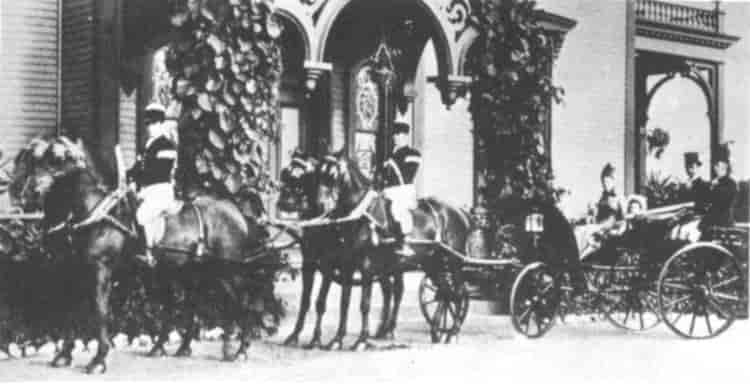
The Peters’ ladies’ phaeton depicted in the old photograph above is turned out à la grande daumont. This equipage took its name from the Duc d’Aumont, a French leader of fashion both before and after the French Revolution who introduced this style during the Restoration. In this country it was presented to formal society at Newport, Rhode Island by Mrs. August Belmont, wife of the Rothschild banker and mother of Newport’s noted brothers, O. H. P. and Perry Belmont.
The lady’s driving phaeton (below) is harnessed in the simpler à la demi daumont. The two carriages here illustrated are not in the museum collection, but depict the alternate method of harnessing when the postillion rides the near horse, or if four, the near leader and wheeler.
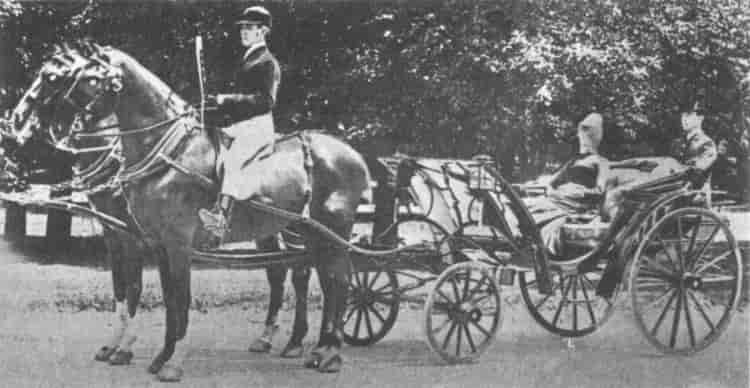
[6]

BASKET PHAETON
Black with basket weave seat. Trimmed in blue broadcloth.
The pony basket phaeton was deservedly popular—especially with women—as it required little skill to keep the body in order, was light in weight and of small initial cost.
Prices and weights for the best make phaetons showed a wide variety, depending upon which type was purchased. The schedule below was published by James A. Garland about 1900 (The Private Stable):
| Type of Phaeton | Price | Weight in Pounds |
| Basket (single) | $400 | 350 |
| Basket (pair-horse) | 750 | 700 |
| Ladies’ | 1150 | 800 |
| 1450 | 1200 | |
| Spider | 1150 | 800 |
Light and airy in appearance, this basket phaeton was used by its owner as a summertime vehicle. It was built by the Hume Carriage Company of Amesbury, Massachusetts.
Gift of Mr. Arthur Brown, Tilton, New Hampshire.
[7]
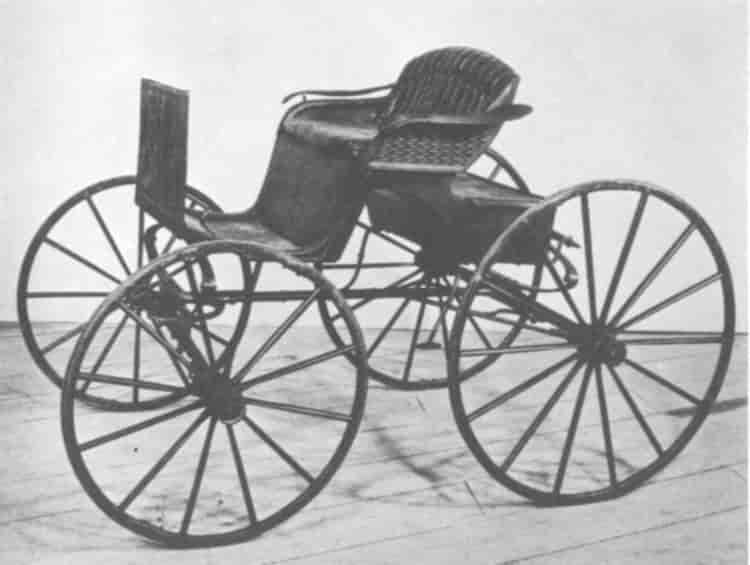
MINIATURE PHAETON
Canework body painted black; wheels black with red striping. Trimmed in black leather.
This little phaeton was made especially in a miniature size for Tom Thumb of Bridgeport, Connecticut. P. T. Barnum first heard of the perfectly-formed twenty-four inch sixteen pound child in 1842. He secured his services for $3 per week and exhibited him at his New York Museum. The child was exceptionally bright and Barnum undertook his education, hiring a tutor and a French professor for him. Tom Thumb with his parents, Barnum and the complete entourage sailed in 1844 for Europe and the first of a number of prosperous tours. He became the favorite of Continental royalty, as well as a pet at Buckingham Palace.
In 1862 Barnum contracted for the services of the perfectly formed dwarf girl, Lavinia Warren, of Massachusetts, and the love marriage of these two tiny people captured the romantic attention of every American. Tom Thumb died when he was 45 years old—still tiny in height, but by then a portly 70 pounds in weight.
[8]

CURRICLE
Body painted dark green; gear green. Trimmed in tan broadcloth.
James W. Burgess in 1881 in his treatise on Coach-Building pointed out that in the last years of the 17th and in the early years of the 18th century “a vehicle much in fashion was the curricle, which had been in use for some time in Italy where it was suspended from leather braces. Springs were added by the French ... the English altered the shape, giving the back a graceful ogee curve, improved the hood and added a spring bar across the horses’ backs. It was a vehicle of easy draught, and could be driven at great speed. Unfortunately it was rather dangerous if the horses shied or stumbled, and this tended to reduce the demand for it, although Charles Dickens used one as soon as he could afford it, and Count D’Orsay had one made as late as 1836.”
This curricle, an extremely rare type of carriage, was built by Brewster and Company of New York just before the turn of the 20th century.
[9]
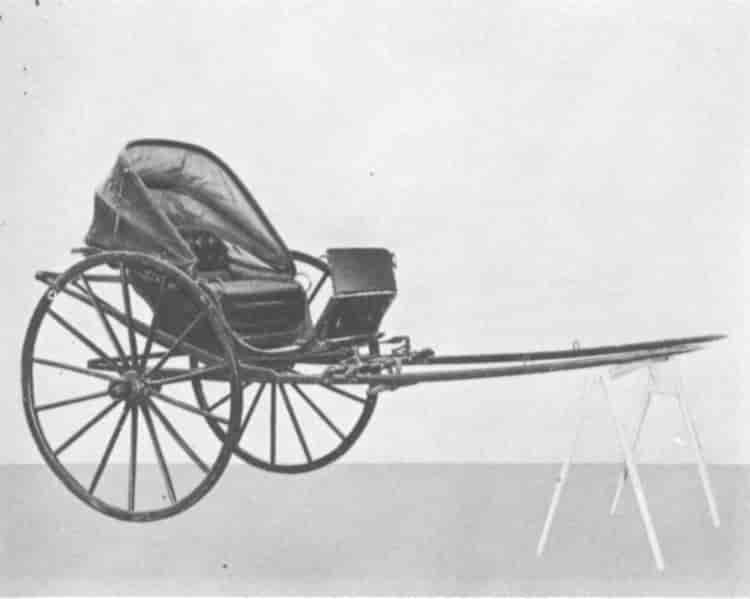
CHAISE
Body painted black. Trimming: black leather top and cushions (restored in 1953).
The chaise has been defined as a two-wheeled carriage for two persons with a calash (folding) top and the body hung on leather straps or thorough-braces.
This chaise was purchased from the descendants of Gen. John Stark of Dunbarton, New Hampshire where the family homestead is located. Tradition has it that Gen. Stark met the Marquis de Lafayette in Concord, New Hampshire and drove him to the Stark home in this chaise where Lafayette visited with Stark during his 1784 visit to America.
John Stark was one of the most colorful heroes of the Revolutionary War and a special hero of Vermont, for it was at the Battle of Bennington that Stark overwhelmingly defeated the British forces on August 16, 1777. “Bennington Battle Day” is Still celebrated every year in Vermont, and is a state holiday.
[10]

DOCTOR’S GIG
Body painted black. Trimmed in black leather.
The gig was an exceedingly light vehicle and in reality was only a chair fixed on shafts. Well adapted for traveling purposes, it was a favorite of doctors and businessmen.
Of particular note is the method of springing used in this gig. Two sloping members are bolted through the shafts to which are attached the suspension leather braces. This ingenious form of suspension is typically American and one which substituted for the heavier and costlier methods of springing.
This gig belonged to Dr. Zacheus Bass of Middlebury, Vermont, who practiced in Addison County from 1815 to 1881. He accompanied Vermont troops to Plattsburgh, and during 1814 assisted in caring for the wounded on Commodore MacDonough’s ship.
On loan from the Sheldon Museum, Middlebury, Vermont
[11]
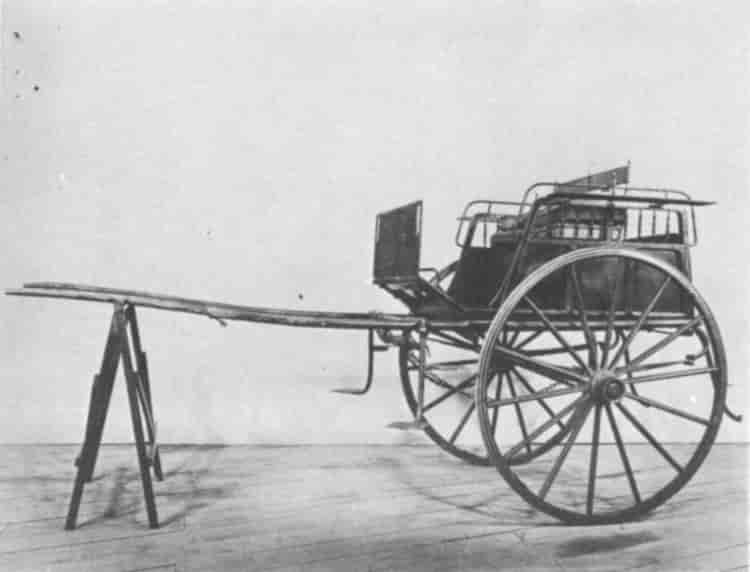
DOG CART
Olive green, picked out with yellow. Trimming: tan tweed.
The dog cart, when setters and pointers were used for pheasant and partridge shooting, was a useful vehicle to transport the dogs to distant shoots, but outlived its usefulness for this originally conceived purpose. Over the years it changed its shape, with the high wheels and lofty driver’s seat giving way to a low, rakish line. The profile of the body varied also, sometimes sloping side lines were the fashion; other years the upright line was in favor.
In 1883 a lever permitting the whole body of the vehicle to be moved backwards or forwards was patented. This simple device, located directly below the driver’s seat, allowed the driver to change the center of gravity of his dog cart, depending upon whether two or three persons were riding as passengers, thereby easing the load on the pony or cob drawing the cart.
This dog cart was built by Fred F. French, carriage maker of Boston, Massachusetts.
Gift of Mr. Arthur Brown, Tilton, New Hampshire.
[12]

TANDEM CART
Black body, yellow gear striped with black. Trimmed in tan cord.
Tandem driving (two horses, one behind the other) originated with sportsmen in hunting countries who took their hunter to cover in harness as the leader of two horses. He was expected to simply jog along comfortably with the wheeler, or second horse, pulling the cart. This custom of driving became popular and more or less of a sport in itself.
Some authorities depreciated tandem driving, but Frederic Ashenden who wrote the notes on tandem and four-in-hand driving for The Private Stable differed. He pointed out that it had always been his custom to give a tandem pupil half a dozen lessons in four-in-hand driving first before attempting tandem, for he felt the reins were more easily handled with four. Francis W. Ware, author of Driving agreed, for as he said, a four would keep each other straight, but any bungling with the reins would surely be communicated to the tandem team and upset their work.
Gift of the Webb family in memory of Dr. and Mrs. Seward Webb
[13]
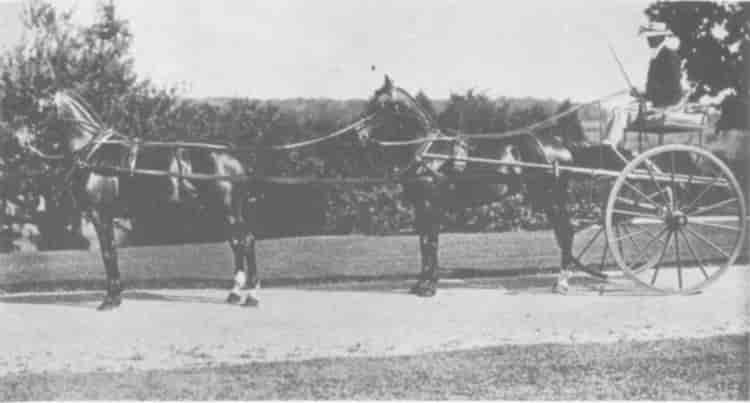
TANDEM DRIVING
“Let anyone while he is young and has strong and steady nerves, a quick eye and patience to learn his business thoroughly, try it, and perhaps he will not repent. Let him begin by learning the uses, places and combination of the harness to the last buckle. Then if he can find a good professor, let him sit beside him, watch, listen and learn.... Then he may go far and certainly might fare worse.” Major-General Sir C. Teesdale.
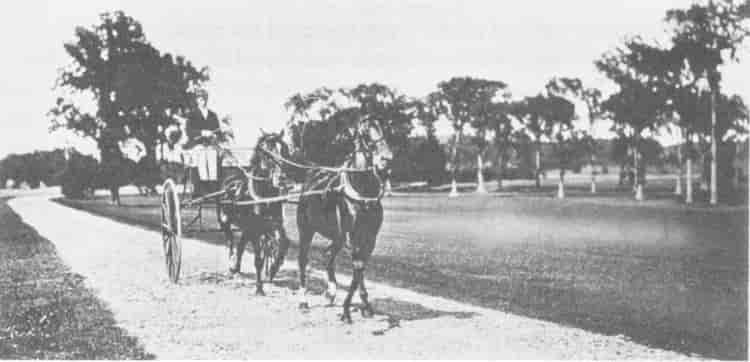
These two photos showing Mr. J. Watson Webb driving the homemade tandem practice cart were taken about 1903 in Shelburne, Vermont. The two horses are Mary (leader) and Auburn Maid (wheeler).
[14]

“GOING-TO-COVER” CART
Black and white with red gear. Trimmed in eggshell corduroy.
This dog cart was one of the types approved for tandem driving by the Tandem Club of New York. In design it was copied from a dog cart shown in the print by C. C. Henderson entitled Going-to-Cover, which has been described by authorities as a truly ideal sporting picture of the tandem team. Originally the dogs would have been taken to cover in the capacious boot which was ventilated on either side with louvered spaces.
Tandem driving was practiced by the ladies as well as by gentlemen, and in fact Lady Georgiana Curzon wrote the tandem chapter in Driving, the volume on that sport written for the Badminton Library of Sports and Pastimes, published in 1889.
This cart was built by Brewster and Company of New York.
Gift of Mrs. Gambrill in memory of her husband, Mr. Richard V. N. Gambrill
[15]
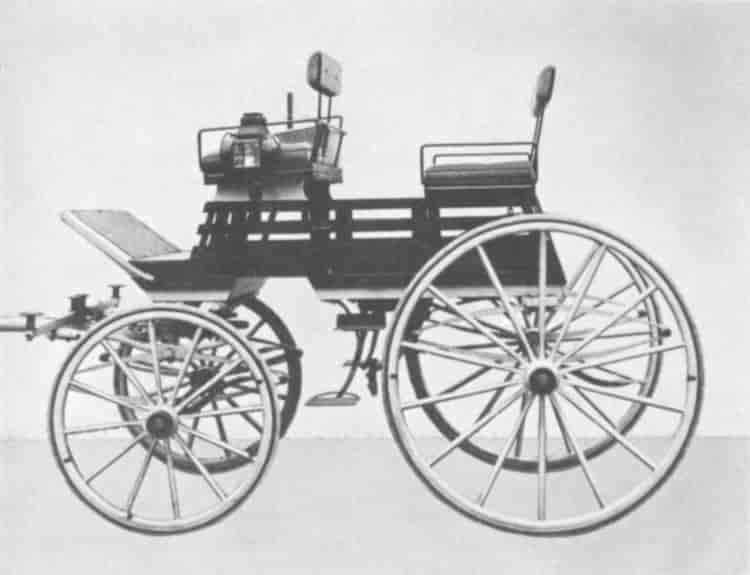
SHOOTING CART
Body painted black; wheels and gear yellow. Trimmed in tan printed pinwale corduroy, black pattern.
This type of vehicle is also known as a Slat-side Phaeton and is described by Francis C. Underhill (Driving for Pleasure) as a modification of a vehicle used on the other side of the water in a lighter construction. It is intended for private use in the country with a team or a pair and would have been found among the vehicles in the coach barn of a connoisseur of carriages. The body work on the shooting cart is similar to that found on the four-wheel dog cart.
This cart was built in 1894 for Dr. Webb by Brewster and Company of New York.
Gift of the Webb family in memory of Dr. and Mrs. W. Seward Webb
[16]
NON-SPORTING CARRIAGES

BROUGHAM
Body painted dark green, green gear. Trimmed in green leather.
The story of the origin of the brougham about 1837 was published in 1889 by George N. Hooper—at that time president of the Institute of British Carriage Manufacturers. Lord Chancellor Brougham, lawyer, orator, writer, innovator and originator of many ideas on many subjects, took his plans for a refined and glorified vehicle similar to the street cabs, just then making their appearance in London, to his carriage maker who refused to produce the vehicle because it was light and lacking in dignity in his estimation. A neighboring coachmaker accepted the challenge of this new type of carriage and in gratitude Brougham did his best to influence the world of fashion to purchase this vehicle which revolutionized the old methods of carriage building as regards lightness, handiness, ease of access and economy.
This brougham was built for Dr. and Mrs. Webb by Brewster and Company of New York.
Gift of the Webb family in memory of Dr. and Mrs. W. Seward Webb
[17]
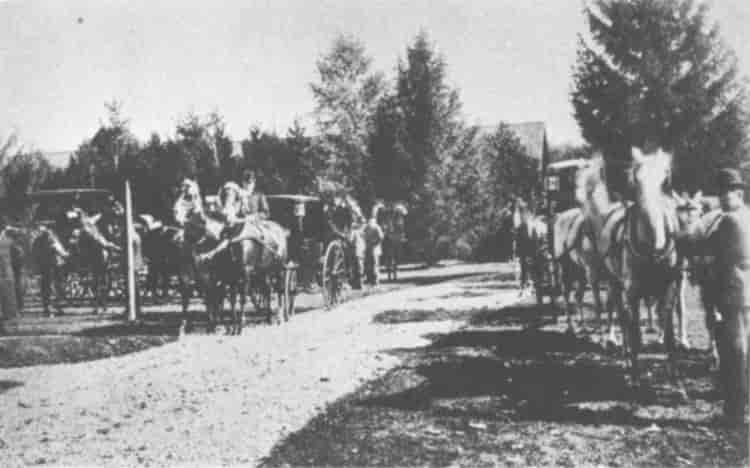
(Above) The brougham, formerly owned by Dr. Webb, parked outside Trinity Episcopal Church in Shelburne, Vermont during the marriage ceremony of Miss Frederica Webb and Mr. Ralph Pulitzer in October of 1905. After the wedding, Dr. and Mrs. Webb returned to their home at Shelburne Farms in the brougham and the lower photograph shows the carriage entering the home grounds.

[18]

LANDAU
Body painted dark green, black trim with straw color striping. Trimmed in dark green morocco leather and blue broadcloth.
The landau originated in the German town of that name and was used from mid-18th century as a posting (traveling) or dress vehicle. About 1850, coachbuilders began to use the lighter elliptic springs on the landau and the whole vehicle became more miniature in size. The landau combined the virtues of both an open and close carriage, as the folding heads could be dropped and the windows lowered.
Landaus with curved body lines were known as Sefton landaus and those with angular lines as in this example were called Shelburne landaus after the Earl of Shelburne who had the first of this pattern built to his order.
This carriage was built by the famous Brewster and Company and belonged to the Theodore Havemeyer family.
Gift of Mr. Henry O. Havemeyer, Mahwah, New Jersey.
[19]
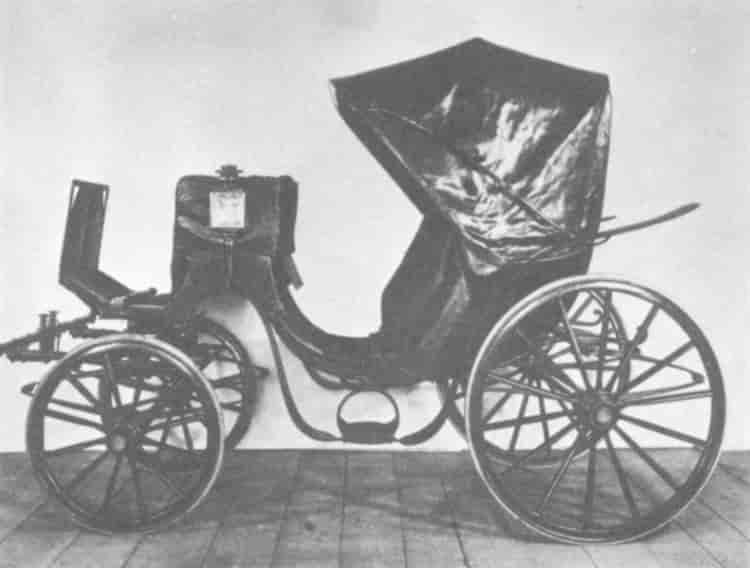
PANEL-BOOT VICTORIA
Body painted black with black wheels. Trimmed in navy blue broadcloth.
The victoria became the fashionable park carriage when in 1869 the Prince of Wales imported one from Paris for his mother, Queen Victoria, for whom the carriage was named. When she appeared in it for her daytime drives, it soared in popularity. Known at first as the victoria phaeton, it was in truth a faithful copy of the George IV phaeton with a box added for the coachman to drive from. It was always turned out in formal style and is somewhat of a symbol of the reign of Queen Victoria.
This carriage was built by Henry Hooker and Company of New Haven, Connecticut, and tradition has it that both Presidents Arthur and Harrison were passengers in it during their visits to New Hampshire.
Note the “slip linings” on the boot and the leatherette apron pulled over the interior upholstery. These served as dust protection for the finer vehicles in the coach barn.
Gift of Mrs. Charles E. Tilton, of Tilton, New Hampshire.
[20]

SKELETON-BOOT VICTORIA
Body painted dark olive green, green gear. Trimmed in dark green.
The handsome victoria was well suited for the formal call and the promenade on wheels. In 1877, Mrs. E. B. Duffey, in her Ladies’ and Gentlemen’s Etiquette book warned her readers that “morning calls should not be made earlier than twelve noon, nor later than 5 P.M. and the lady should be more richly dressed when calling on her friends than for an ordinary walk.” A lady should “never lay aside her bonnet during a formal call even though urged to do so.”
The rules were just as rigorous where her carriage was concerned. Her coachman, stately in bearing, should be taller and more portly than the footman, but he too should be of more than average height, thoroughly well trained and preferably slim.
This victoria was built by Brewster and Company of New York in 1904.
Gift of the Webb family in memory of Dr. and Mrs. W. Seward Webb
[21]
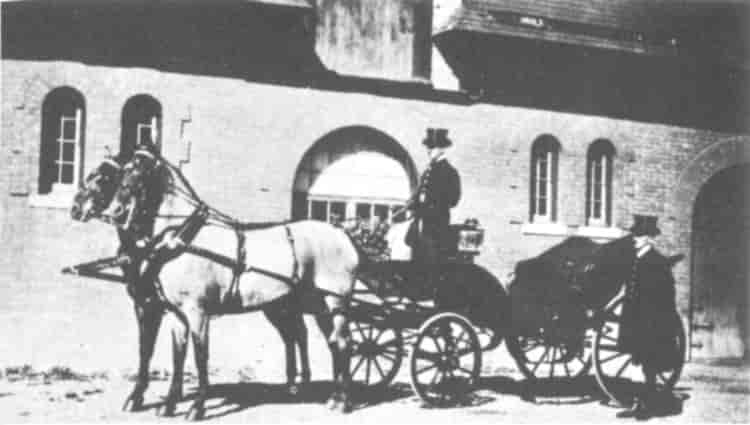
Photos above and below were taken in the courtyard of the coach barn at Shelburne Farms about 1905 and show the victoria turned out, ready for a formal call.
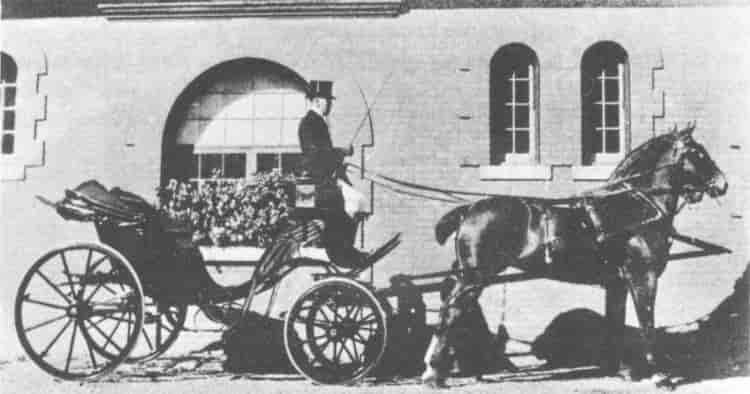
Fine carriages were never neglected. Each vehicle was thoroughly washed off as soon as it came in the coach barn; grit was carefully removed from hinges and joints; only the finest chamois were used to wipe dry the painted panels. Linseed oil was applied to the folding leather tops, and all metal parts on lamps and moldings were kept brightly polished. This was routine care in well-regulated stables.
[22]

VIS-À-VIS
Body painted dark olive green, green gear. Trimmed in dark green.
The vis-à-vis was known as the sociable in England and appears with a panel body (as in this example) or with a basket-work body. When it was properly turned out, it was formally horsed with two horses of fifteen hands each and carried either one or two “trim dapper servants,” the groom being a trifle smaller and shorter, as it was not good taste to have the groom or footman show more height on the box than the coachman.
Given by the Webb family in memory of Dr. and Mrs. W. Seward Webb
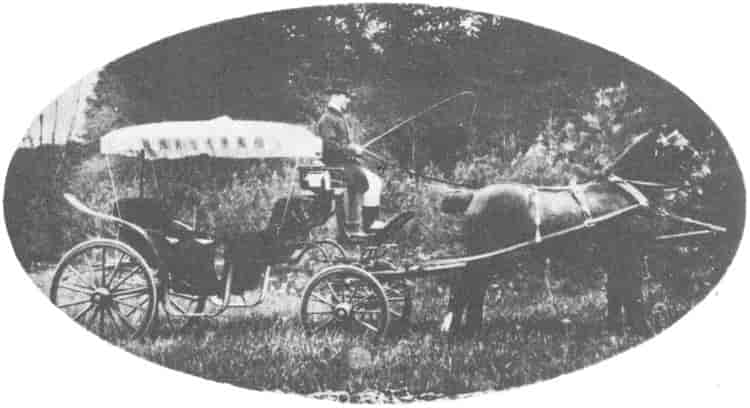
[23]
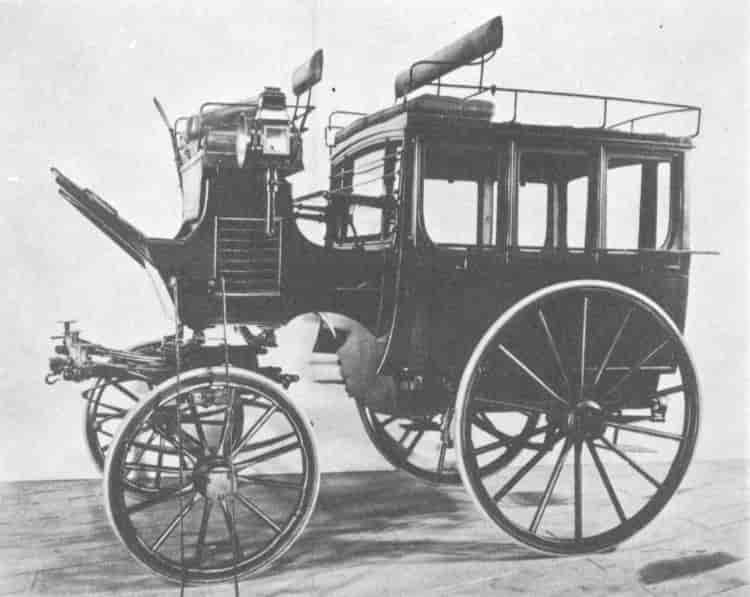
PRIVATE OMNIBUS
Body painted dark olive green, green gear. Trimmed in green leather.
The omnibus, one of the larger carriage types, was intended for owner driving as well as coachman driving and could be used with two horses; three horses abreast with an adjustment of the two poles, and for long distances over heavy country roads; or (even though it did not class as a proper four-in-hand vehicle) with four horses. At coursing and race meets, the omnibus made an admirable and roomy grandstand.
The lazyback and cushion on the roof seat were removed when the omnibus was servant-driven unless the seat was needed for the transporting of house servants. When the omnibus was temporarily transformed into a four-in-hand and owner-driven, the servants in undress liveries rode inside, with the owner and his guests occupying the box and roof seats.
This omnibus was built in 1891 for Dr. and Mrs. Webb by Brewster and Company, of New York.
Given by the Webb family in memory of Dr. and Mrs. W. Seward Webb
[24]

CALÈCHE
Body painted dark olive green, green gear. Trimmed in morocco leather and broadcloth.
The calèche was a grand carriage and belonged to the “state” order. As Francis Underhill wrote in 1896: “It is not at all suited unless the stable be supplied ... with numerous carriages. It is intended simply for the most formal calling or for park work.” The horses required were of the finest breeding, perfectly matched and with faultless manners. The harness was elaborate and included breeching (that part of the harness which passes around the hind quarters of the horse) and loin straps.
This calèche was ordered in Paris, France by Dr. and Mrs. Webb in 1890 from the famed French carriage maker, Million et Guiet. It was used in New York until about 1900 with the two superb Webb horses “Chilcat” and “Chilcoot,” (17.1 and 17.2 hands respectively). After the death of one of these perfectly matched big horses, the calèche stood unused in the Webb coach barn for many years.
Gift of the Webb family in memory of Dr. and Mrs. W. Seward Webb
[25]
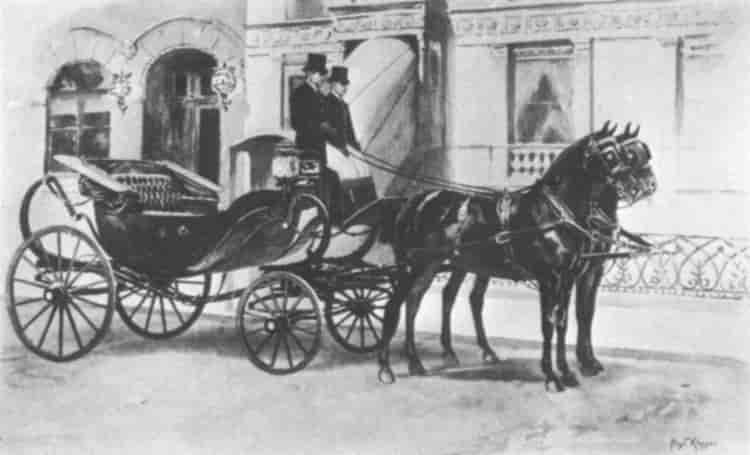
(Above) Watercolor of the calèche painted by Max Klepper about 1895.]
(Below) Detail showing elaborate springing, carving and C springs at rear of calèche. Note buckle for tension adjustment of leather strap.]
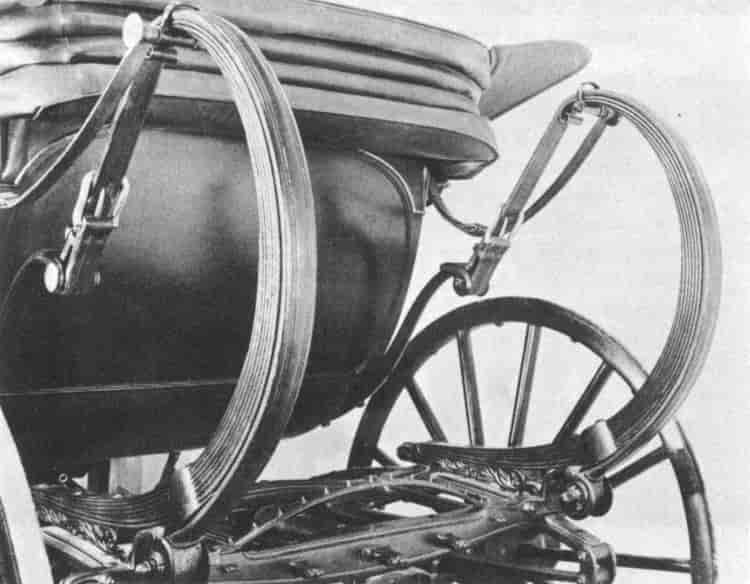
[26]

BERLIN
Body painted dark olive green with deeper green trim, green gear. Trimmed in green silk satin.
One of the first carriage forms, the berlin was invented about 1660 in Germany, and much used on the European Continent for royal traveling with two or four horses, two men on the box, two grooms standing on the rear, and out-riders for protection.
When the berlin here illustrated was harnessed à la grande daumont, the box was removed by loosening the bolts, and the mounted postillions then drove from the two near side horses. The berlin was truly a state carriage with its well-balanced lines and air of luxury without ostentation.
This berlin was built for Dr. and Mrs. Webb in France by Million et Guiet, and imported to America in 1890. It was used with the marvelously matched Webb horses Chilcat (17.1 hands) and Chilcoot (17.2) in New York.
Gift of the Webb family in memory of Dr. and Mrs. W. Seward Webb
[27]

On the festive occasion in October of 1905 for Miss Frederica V. Webb’s wedding to Mr. Ralph Pulitzer, the berlin was harnessed à la grande daumont, with Mr. J. Watson Webb on the leader and Mr. W. Seward Webb, Jr. on the wheeler. This equipage, with the two brothers riding postillion for their sister, brought the bride and groom home to Shelburne Farms from Trinity Episcopal Church in Shelburne after the ceremony.
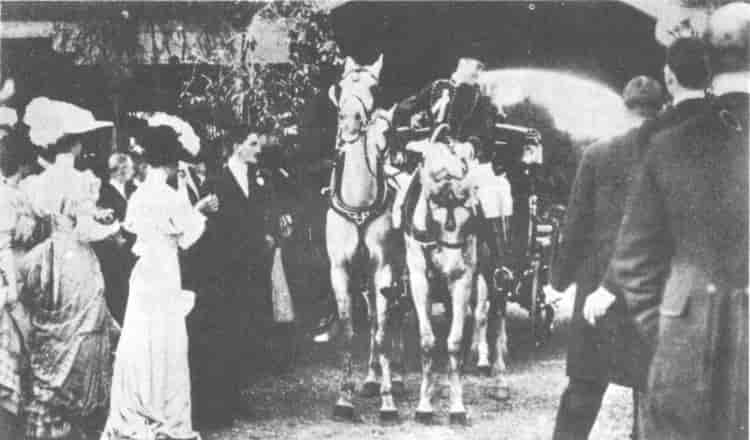
[28]

CARROLL COACH
Black with white striping; gear is black with yellow striping. Trimming: gold-on-gold damask.
An unusually fine example of a private coach of the mid-19th century, made to carry six persons in addition to the coachman and footman.
The woodcarving trim on this coach, which originally was owned by George W. Carroll of Carrollton, Isle of Wight County, Virginia, is of especial note. The carved double leaf motif is in keeping with the size of the coach. The Coach Makers’ Illustrated Hand-Book in its chapter on woodcarving warned that “The coach and carriage of smaller dimensions will not admit of great boldness in design, but every portion requiring decoration will admit of a well-conceived design and delicacy of workmanship.”
This coach has an unusual amount of white striping on the body and the carving has been emphasized by the addition of a white outline.
[29]
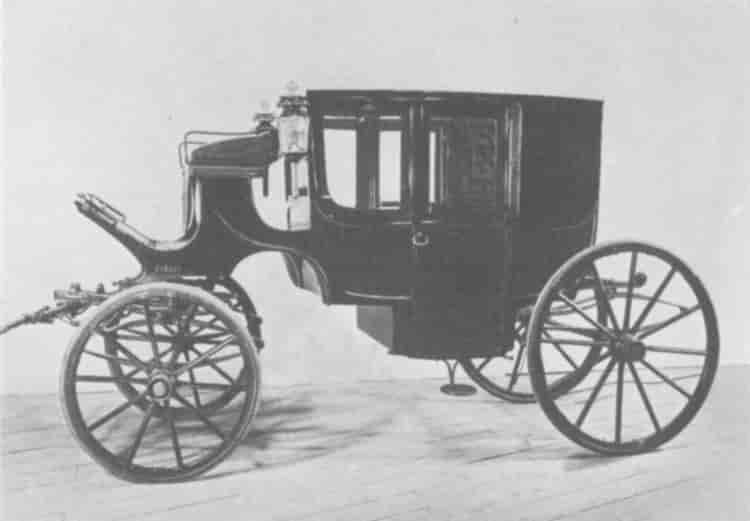
FORMAL COACH
Body painted dark green with black top. Trimmed in dark green leather and broadcloth with dark green padded satin ceiling.
Traditionally, one of the first carriages in England was the coach brought out of the Netherlands by a Dutchman as a gift to Queen Elizabeth “who had been seven years a queen before she had any coach.”
The coach through the years maintained its place as the “chief of every class,” and so while many vehicle-constructing concerns could add the designation—“carriagebuilder”—after their business names, only a few deserved the appellation—“coachmaker.”
This formal or dress coach was used in and around Bennington, Vermont. It was built by Jas. Cunningham Sons & Co., Rochester, New York.
Gift of the directors of the Henry M. Tuttle Company, of Bennington, Vermont, in memory of Mr. Fred Stickles, for many years president of that company.
[30]

IRISH JAUNTING CAR
Body and wheels painted black.
Also known as outside car, Irish side car, jogging cart. In 1889, the Duke of Beaufort writing his volume on Driving for the Badminton Library Series pointed out that “the outside car, so common in the land of Ireland itself, has made little way elsewhere. It may be described as a dog cart body hung sideways, but the similitude goes no further, for it is suspended on a pair of low wheels which revolve inside, or rather under the body.... The driver sometimes sits on a separate seat in front and at other times on one of the side seats. To ride on or drive an Irish car requires a certain amount of teaching, training or practice. Visitors from other countries are very apt to be thrown off into the road if the driver is humorous or lively and turns a street corner quickly; any stranger who rides on an Irish car ought to be advised to hold fast and not relax his hold till he has safely ended his drive.”
This car was made in Dublin, Ireland for Mr. William C. Indicott who in 1930 presented it to Mr. Charles Sumner Bird.
Gift of Mr. Charles Sumner Bird of East Walpole, Massachusetts.
[31]
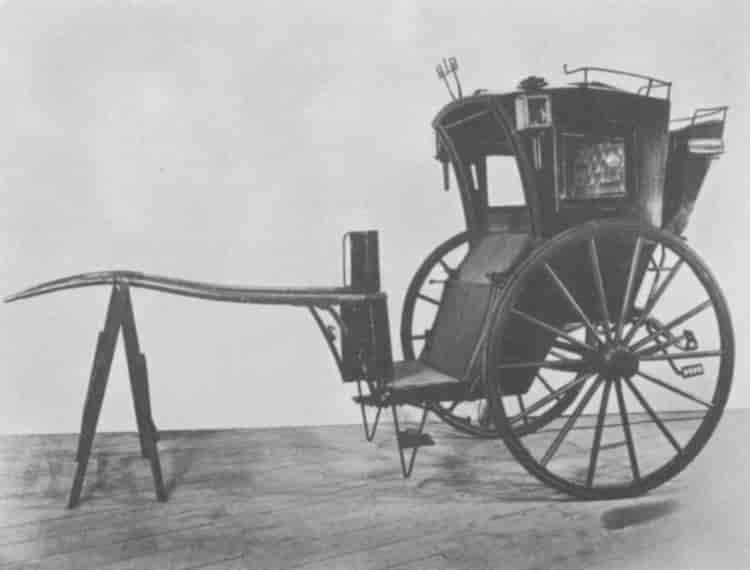
HANSOM CAB
Body painted black; gear painted red. Trimmed in black leather.
Joseph Hansom, the inventor, patented this type of cab (which is the shortened form of cabriolet) in 1834. Forder, another coachbuilder, redesigned it in 1873 and it became a popular carriage for hire, both in this country and in even greater numbers in England where it was known as the “gondola of London.” Limited amounts of luggage could be carried on top of the cab and in the space between the apron and dashboard.
This hansom, as evidenced by the baggage rail on the roof, was a public conveyance, but these vehicles also found a place in town stables as private cabs during the latter years of the 19th century. Essentially a man’s carriage for town use, they were often finished in flash colors. The servant who drove the private hansom wore a dark cutaway, trousers and high felt or derby hat. In cold weather he was supplied with a cloth overcoat and a lap rug; in rainy weather an “upper benjamin” or poncho-like garment in a waterproof material and a weather-apron to protect his trousers.
[32]
COACHING AND OTHER FOUR-IN-HAND VEHICLES

ROAD COACH “LIBERTY”
Body painted maroon and black, red wheels. Trimmed in leather.
This famous road coach LIBERTY was built in Paris by Million et Guiet and is a reproduction of the old royal mail coaches used in England. It was built especially for Mr. James Hazen Hyde, one of the outstanding “whips” of the coaching revival, who had it brought over here and ran it as a public road coach from Holland House in New York city to Laurel-in-the-Pines, Lakewood, New Jersey.
In 1901 Mr. Alfred Gwynne Vanderbilt and Mr. Hyde made a record run in the LIBERTY to Bellevue Hotel in Philadelphia from Holland House in New York and return in the time of 19 hours and 35 minutes. Seventy-eight horses spaced along the route were used in this record-breaking run.
The LIBERTY was also driven up the St. Bernard’s Pass to the Monk’s Monastery in Switzerland by Mr. Hyde, a feat which more than justified his claim to the title “gentleman coachman.”
Gift of Mr. J. Ford Johnson, New York, New York.
[33]
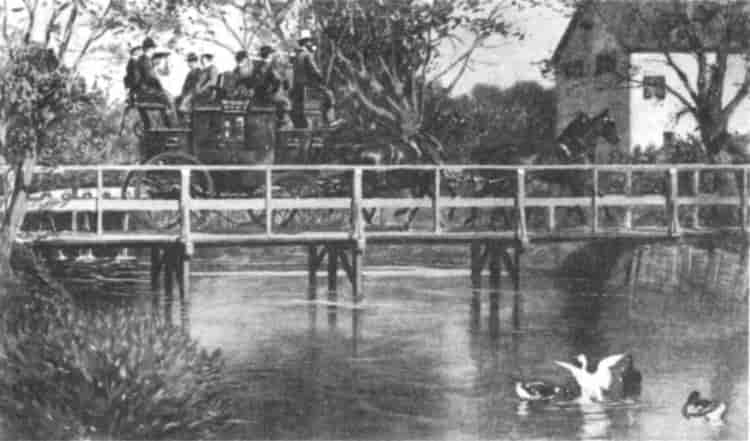
(Courtesy New York Historical Society, New York City)
(Above) Road coach LIBERTY crossing the bridge near Turkey Blue Ball, New Jersey on its New York-to-Lakewood run. Watercolor by Max Klepper painted 1903, one of a series of twelve showing the different views along the route. These paintings may be seen at the New York Historical Society—gift of Mr. James Hazen Hyde.]
(Below) Pen and ink water color by Crafty showing the road coach LIBERTY in France. Gift of Mr. James Hazen Hyde to Shelburne Museum.]
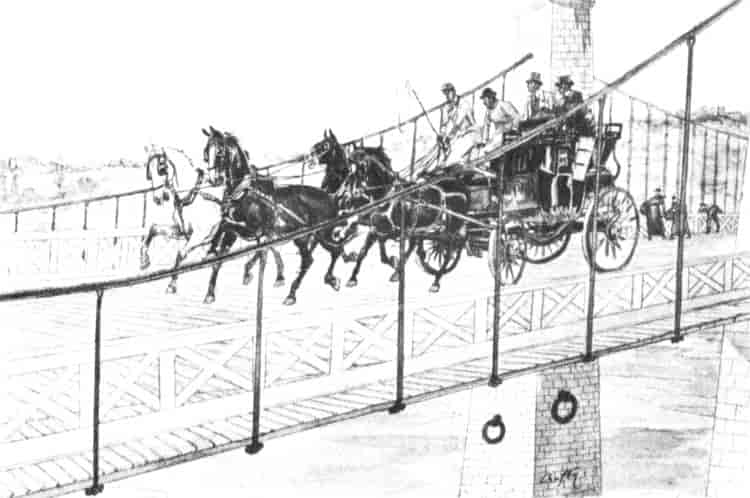
[34]

PARK DRAG
Body painted dark olive green, green gear. Interior trimming is in green leather; exterior trimming is in tan cord.
The park drag resembles the road coach but is a lighter vehicle and is intended for four-in-hand driving by the owner-coachman for his own amusement and that of his friends.
The Coaching Club of New York each year sponsored Meets for their members. Sometimes these drives occupied an hour or so and the coaches returned to point of departure and there separated; on other occasions the coaches went to some out-of-town place for lunch or dinner and returned independently.
Fairman Rogers in his Manual of Coaching (1899) mentions the placement of passenger load for these Meets: “The wife of the owner, if he has one, takes the box-seat (with him); two ladies and two men on the front roof-seat, the back of the hind roof-seat is turned down and the two grooms are in the rumble ... in the case of mourning, when the wife of a member does not, for that reason, wish to appear at the Meet, a lady takes her place, or the load is made up of men only.”
[35]
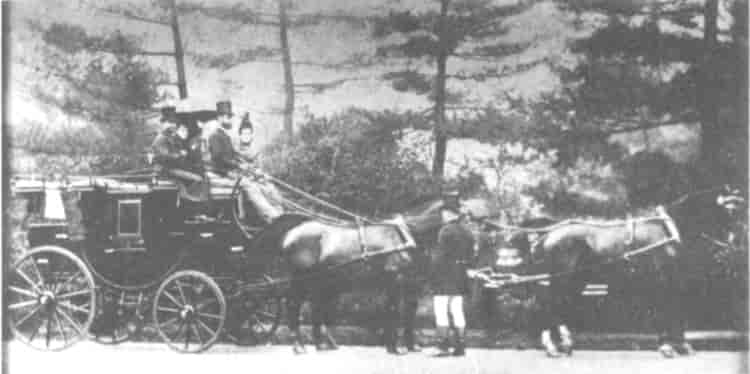
“The only occasion on which the wife of the owner, if she is on the coach at all, is not on the box-seat, is when a very distinguished personage such as the President of the United States takes that seat on the leading coach. If the owner is unmarried, the lady on the box is usually one of his own family.”
The photograph above taken in Central Park, New York, shows Dr. and Mrs. Webb on the box at the commencement of one of the Coaching Parades. In the lower picture, Miss Frederica V. Webb (daughter of Dr. and Mrs. W. Seward Webb) handles the “ribbons” for the Ladies’ Coaching Parade. Her brother, Mr. J. Watson Webb, is on the box seat with her.
Gift of the Webb family in memory of Dr. and Mrs. W. Seward Webb
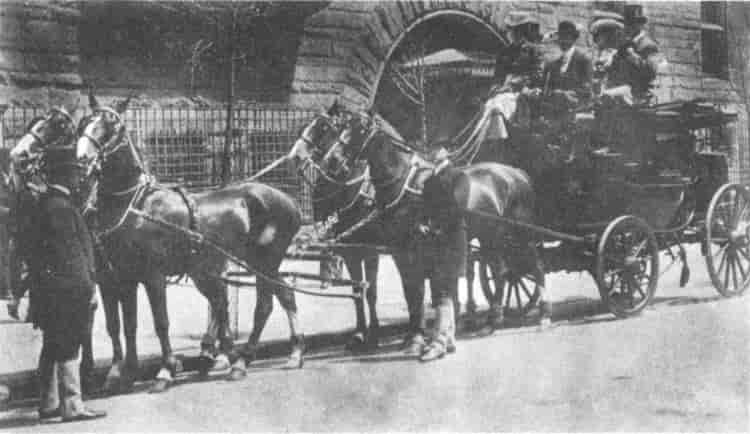
[36]

ROAD COACH “DEFIANCE”
Body painted black with red gear. Varnished interior; wicker seats.
The DEFIANCE was built by Brewster and Company, New York for Mr. C. Ledyard Blair, father of the donor, and belonged to him over a period of nearly 50 years. Originally painted in his colors, primrose and black, the coach was driven in many parades and on coaching club trips. In 1935 Mr. Blair presented this coach to Mr. Richard V. N. Gambrill, husband of the donor, and at that time it was repainted in the regular Gambrill colors.
These coaches were copies of the earlier English mail coach and each was given its own name. Points of departure, destination and intermediate towns were painted in bright colors to a set pattern, and the names “Vernon Manor, Peapack, Gladstone, Far Hills and Bedminster” appear on this coach.
Gift of Mrs. Gambrill in memory of her husband, Mr. Richard V. N. Gambrill
[37]
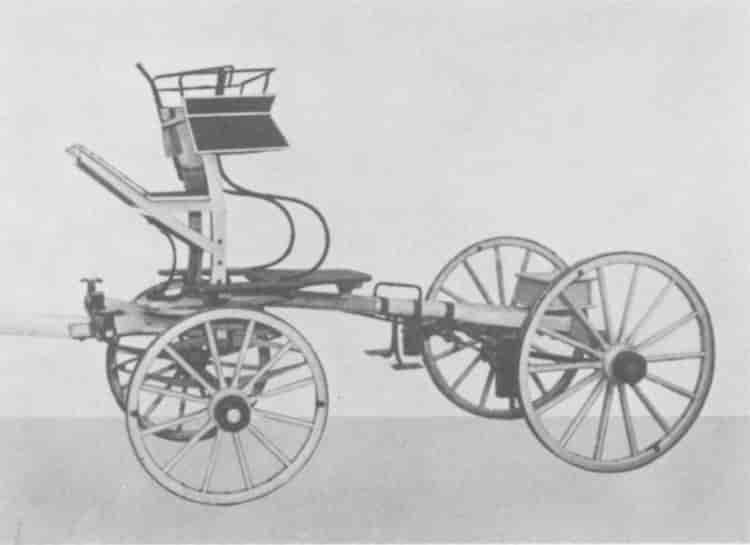
SKELETON BREAK
Body and gear painted bright yellow with black.
The skeleton break (or brake) was used to exercise the four-in-hand team and also for breaking the team to harness. The driver’s seat was placed high and this offered him some protection in his dangerous task of putting-to and subduing the horses when they first commenced their team work. Youngsters or fresh horses would be put-to in double harness to a break with an old and reliable specially trained “break horse” or “schoolmaster.” An additional stable-helper would usually stand on the front platform holding on behind the box so that he was free to jump easily on or off as occasion demanded, thus leaving the driver free to cope with his inevitable problems brought on by the high spirits of the fresh “young one.”
This skeleton break was built by Brewster and Company of New York.
Gift of Mr. F. Ambrose Clark of Cooperstown, New York.
[38]

BODY BREAK WITH PERCH
Body painted dark olive green, green gear. Trimmed in tan cord.
The break (or brake) was a most useful adjunct to establishments where four horses were kept, as it could be used to exercise the team, or as an alternative to the road coach for four-in-hand work when the road coach or drag would be considered too “dressy.” This type of break was also known as a wagonette break.
It was most often used with four horses, although in the country the unicorn team (three horses, one leader and two wheelers) was sometimes used. The break was a most spacious, roomy and useful carriage for station or other rough work. Here the seat length has been curtailed to make room for the additional forward-facing seat which is removable.
This break was built by Brewster and Company of New York and the Webb coat-of-arms has been incorporated on either side in the center spindle.
Gift of the Webb family in memory of Dr. and Mrs. W. Seward Webb
[39]
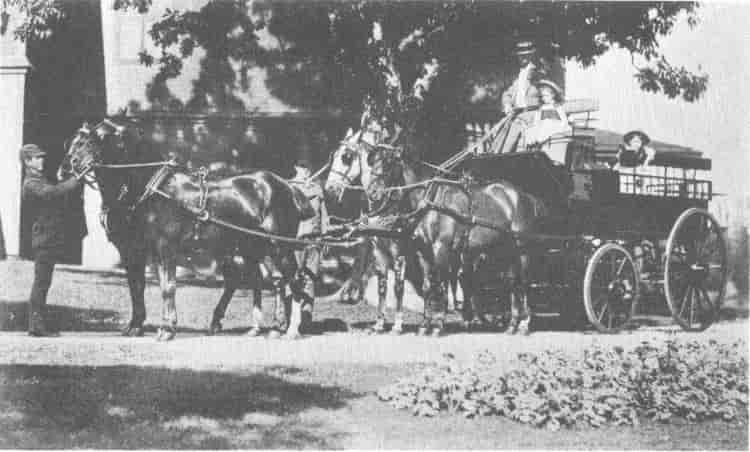
Photo above shows Dr. W Seward Webb with his son J. Watson Webb on the box with him, and his daughter Frederica on the side lengthwise seat. This picture of the body break was taken about 1886 or 1887 at Oakledge, the Webb home in Burlington, Vermont, before they moved to Shelburne.]
In the photograph below, taken about 1903 at Shelburne Farms, the body break is harnessed with four of the first home-bred half-breed hackneys out of native mares.]
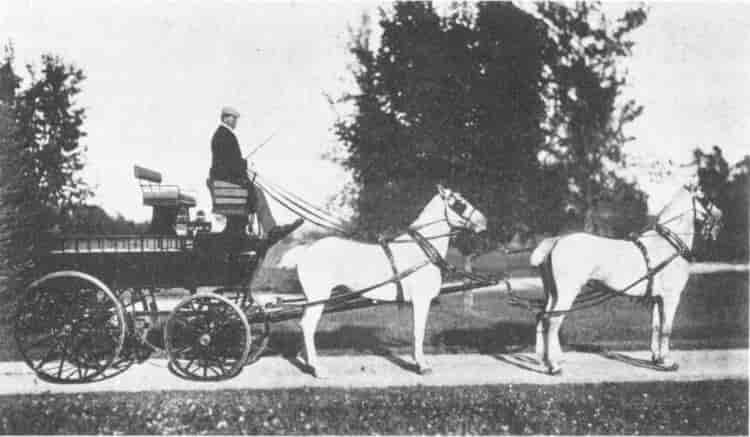
[40]
CARRIAGES OF AMERICAN ORIGIN

THREE-SEAT SURREY
Body painted dark green, green gear. Trimmed in tan canvas.
Because of its great popularity the surrey was stocked even at mail-order houses during the latter part of the 19th and early years of the 20th century. As today there is an automobile for each American, no matter what his financial standing, so in those days there was a carriage manufactured especially for his needs, and one of the mail-order houses advertised that its volume of business was so great that it expected to make only $1 profit on its least expensive model.
The hit song of the musical comedy Oklahoma was the “Surrey with the Fringe on Top” and this vehicle, a particularly elegant and sophisticated version of the surrey, answers that description.
[41]

EXTENSION-TOP SURREY
Body painted dark olive green, striped with red. Trimmed in black.
The extension top used on this surrey was later incorporated into the early auto designs.
This surrey was built in Burlington, Vermont by J. R. and J. H. Lockwood and was used in and around this community for many years by the Wells family, who were connected with the manufacture of dyes and patent medicine. The Wells and Richardson Company commenced business in 1872 and seven years later began an intensive advertising program for their then little-known remedy, “Kidney-Wort.” In 1881 they invested $150,000 in direct advertising—a phenomenal sum at that time, but the sales justified the expenditure, as they mounted to over half-a-million dollars that year. Wells and Richardson also manufactured Diamond Dyes and “Improved Butter Color” and these products earned a world-wide reputation for this Burlington, Vermont business concern.
[42]

DEPOT WAGON OR CURTAIN ROCKAWAY
Body painted black with red gear. Trimmed in black broadcloth.
There were many types of rockaways, but the distinguishing feature of this vehicle is the roof which projected over the driver, assuring him of some protection in inclement weather.
This depot wagon or curtain rockaway also has the enameled leather curtains which could be rolled up on fine days, and yet dropped quickly for protection if caught out in a shower. After a rain storm, the curtains were dressed with sweet or sperm-oil rubbed on with a greased rag, and with proper care, they proved durable and remained pliable for many years.
This vehicle was used particularly to take guests to and from the railway station in suburban Philadelphia, but it also served for shopping expeditions. It was built by Horace Ervien, of Ogontz, Pennsylvania.
Gift of Mr. and Mrs. J. W. Lippincott, Jenkintown, Pennsylvania
[43]
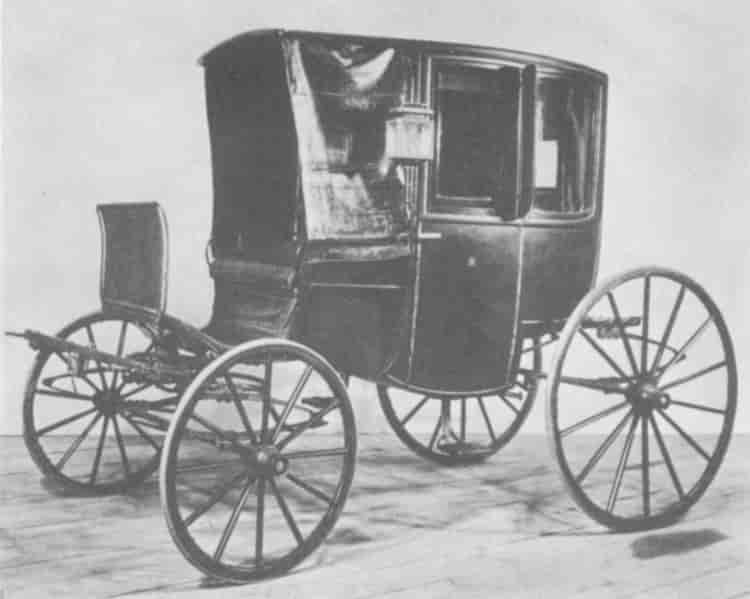
COUPÉ ROCKAWAY
Dark green, striped with red. Trimmed with leather seat, green satin roof interior and padded seat back.
The rockaway was a popular close carriage of both the affluent and not so wealthy American family; in the year 1900, for instance, only 846 broughams (a comparable close carriage) were built as compared with 3,166 rockaways turned out that year.
This vehicle is elegantly fitted out with leather card case, as well as clock case built into the interior lining. It was used by the Wells family of Burlington, Vermont, and was a product of Kimball Brothers Company, Boston; Z. Thompson & Bros. Builders, Portland, Maine. The Wells monogram painted in red on the door panel adds an extra touch of tasteful decoration.
[44]

SIX-PASSENGER ROCKAWAY
Body painted dark green. Trimmed in eggshell corded broadcloth, embroidered with green leaf motif on corded silk fabric.
Although in excellent condition, this rockaway is one of the older vehicles in the collection and was used prior to 1858 by Gen. J. Watson Webb. His daughter Catherine married James G. Benton of the U.S. Army Ordnance Department in 1858, and the Bentons used the rockaway when they lived in Washington, D. C. Benton, a West Point graduate, was the author of many valuable reports on ordnance and wrote the course of instruction in ordnance and gunnery used by the cadets at the U.S. military academy. Col. Benton’s experiments on a new type of rifled musket led to the development of the Springfield rifle, and he superintended the construction of the early models of this gun at the Springfield Armory where he served as commanding officer.
Gift of the Webb family in memory of Dr. and Mrs. W. Seward Webb
[45]
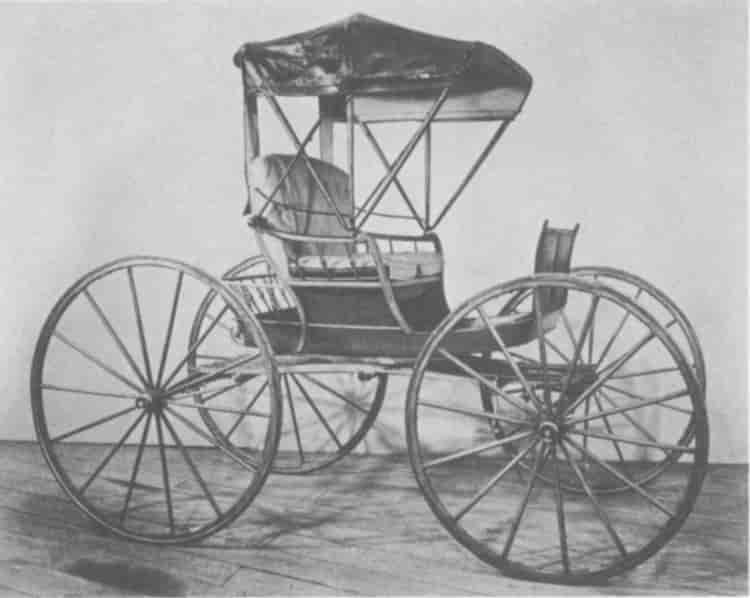
BUCKBOARD PHAETON
Natural color varnished body. Trimmed in tan cord, black leather top.
This buckboard was made by Joubert & White of Glens Falls, New York and was used by Dr. Webb in this community for many years.
The natural varnished body was a deceptively simple vehicle finish. In the Coachmaker’s Illustrated Handbook, published in 1875, the chapter on painting pointed out the hazards of the clear varnish finish: “The varnish can crawl, run, enamel, pit, blotch, sag down and hang on the lower edge; smoke or cloud over; appear as though dust had been dredged on it through a piece of fine mull, or gather up and hang in heavy ridges or beads along the center part of the spokes and other carriage parts. These irregularities will happen with the best quality of varnish and with workmen of undoubted skill, and are caused by atmospheric influences alone.” The English varnish was preferred by carriage painters, for they believed it possessed a secret ingredient which made it the finest available at that time.
Gift of the Webb family in memory of Dr. and Mrs. W. Seward Webb
[46]
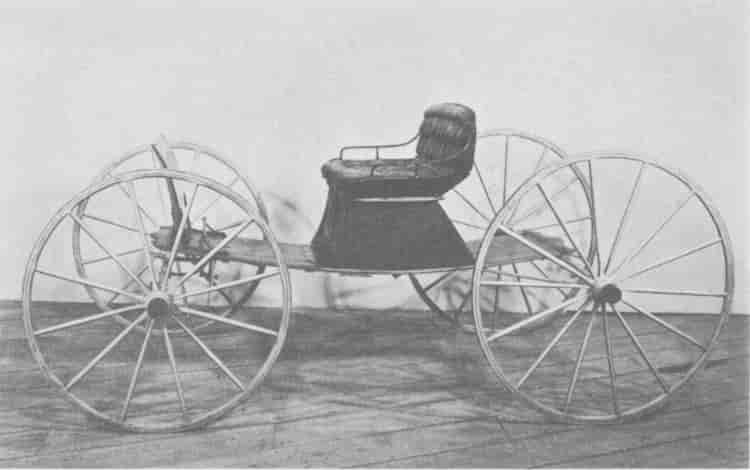
PONY BUCKBOARD
Natural varnished body, yellow gear striped in black. Trimmed in brown corduroy.
This buckboard was used by the Webb children and was pony-drawn. It was made by J. B. Dubuc who was the Shelburne town blacksmith, and whose smithy is now located at the museum, having been moved to the grounds in January of 1956 from its location next to the railroad tracks.
Dubuc came to Shelburne in 1869 from Canada and with his capital of $55 and his trade as a blacksmith set himself up in business. He was the owner of a livery stable, paint shop, harness and carriage shop and operated the meat market here in Shelburne as a sideline. Retiring when his health failed, he took an active part in town affairs, serving as school director and town library treasurer.
Gift of the Webb family in memory of Dr. and Mrs. W. Seward Webb
[47]
These two photos were taken at Shelburne Farms, Shelburne, Vermont in the early 1890’s.

Top photo shows J. Watson Webb (holding the reins) and W. Seward Webb, Jr., sons of Dr. and Mrs. Webb in the pony buckboard.]
Lower photo shows Vanderbilt Webb, the other son of Dr. and Mrs. Webb with his dogs and the family coachman sitting in front of one of Dr. Webb’s buggies.]
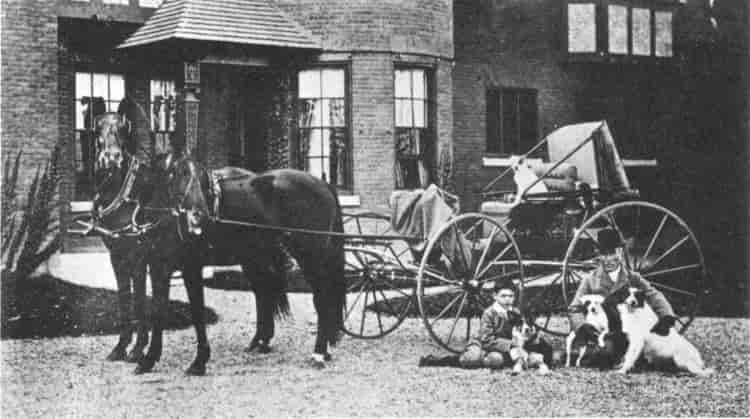
[48]

DOUBLE BUCKBOARD
Body painted black; gear painted red. Trimmed in brown leather.
The true buckboard has been defined as a light four-wheeled vehicle in which the body and springs are replaced by long, elastic boards, supported at the ends directly by the axles. The driver’s comfort, as well as that of his passengers, depended upon the resiliency of the boards themselves, and the buckboard proved a far more comfortable vehicle for long trips than might be expected.
This buckboard was used at the Kildare Club in the Adirondacks in the 1880’s. After this club was sold, the buckboard was used at Nehasane, in Hamilton County, New York, a game preserve and hunting camp owned by Dr. W. Seward Webb.
Gift of Mr. J. Watson Webb, Shelburne, Vermont.
[49]

TRIPLE BUCKBOARD
Body and gear in natural varnish finish. Trimmed with black leather.
Single and double buckboards are often found, but this triple buckboard is considered a rare example. It was made for Dr. E. D. Ferguson of Troy, New York about 1885 to his order in Glens Falls, New York. It descended to his grandson, the little boy sitting with his mother in the rear seat of the buckboard in the old photo below, who gave it to the museum in 1953.
Gift of Mr. and Mrs. Charles Everard Childs, Manchester, Vermont

[50]
UNCLASSIFIED VEHICLES

RACING SULKY
Framework and wheels painted yellow.
This type of two-wheel cart was used for exercising and racing trotting horses. Built as light as possible with practically no body work, these sulkies were really mere frames supporting the single seat.
From mid-19th century, trotting parks and race tracks were established in the New England states. These were the natural outgrowth of the impromptu brushes between drivers on the road. The trot is the most comfortable for the driver and the easiest gait for the horse in harness, and then too the New England Puritan conscience could be quieted with the explanation that light harness racing was in reality an attempt to improve the breed of trotters. Races at local fair grounds gave breeders a chance to see their home-grown stock in action and competition with the “experts” on tour. A prize-winning performance on the track always influenced prices, and many a farmer dreamed of raising a trotter that would one day bring him real fame.
[51]
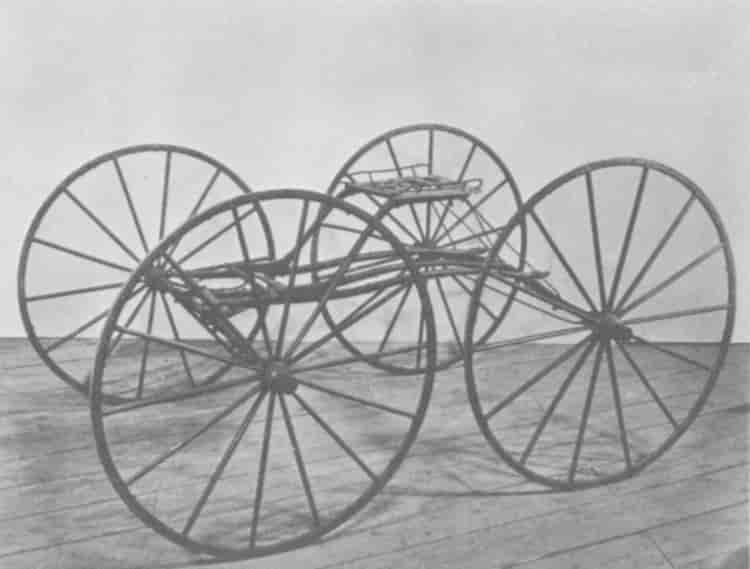
SKELETON WAGON
Body and wheels painted red.
This light racing cart was found in Westford, Vermont and shows the webbed seat and pencil-slim spokes of the early skeleton wagon.
Rural communities here in Vermont have enjoyed harness racing for many years, and Bertha Oppenheim (Winged Seed) depicted the Fourth of July races held in the early years of this century in Ferrisburg, a small community just south of the Shelburne Museum. The brass band had been engaged far in advance; ice cream and lemonade were on sale in the refreshment tents; horses had been entered from as far away as Rutland and Manchester, Vermont—and even from across the lake in New York State. Hundreds of buggies and horses were hitched to fences everywhere and Ford cars were parked on the sidelines too. The racing carts, decorated with many colors, lined the track. The “trots” were exciting, but the free-for-all race was the climax of the celebration.
[52]

TUB CART
Natural color varnish; metal-rimmed ties. Trimmed in brown leather.
Each of the Webb children in turn learned to drive in this little cart dating from about 1883 and made to Dr. Webb’s specifications by a local wheelwright. Wheelwrights often made entire vehicles and served as village carpenters.
Wheel-making consisted of several processes—the hub was first turned by hand lathe and then mortised to take the spokes. Felloes or fellies (the wooden outer rim of the wheel), cut by the bow saw and adzed to shape, were then mortised and fitted to the spokes.
Fitting the outer rim to the completed wheel was the final operation. In the old days the wheel was straked—that is, overlapping iron plates were nailed to the rim of the wheel. About 1850 the hoop tire began to supersede the strake. Here the length of iron was welded into a hoop, heated so that it would expand and then dropped onto the wheel. It was cooled with buckets of water and after shrinking made a tight, secure metal rim for the wheel.
Gift of the Webb family in memory of Dr. and Mrs. W. Seward Webb
[53]
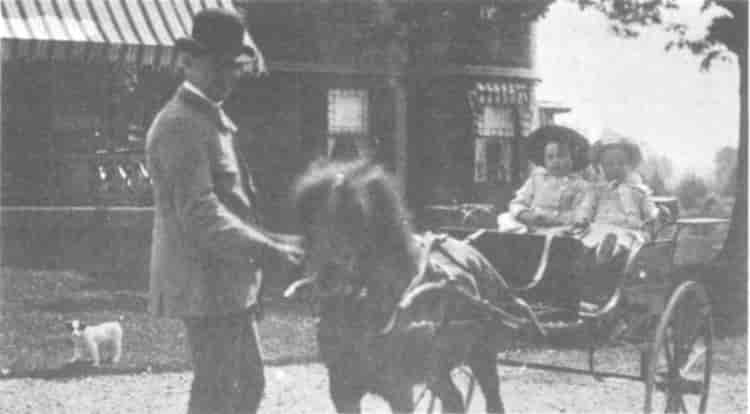
(Above) The Webb head coachman holding the pony and Frederica, aged 4 and J. Watson Webb, 2 years old, each with one of the reins. Even before children could walk, they were given their first driving and riding lessons.]
(Below) Frederica has graduated. She is now 5 years old; her gentle pony is Frieda and she can drive alone. Both these pictures were taken at Oakledge, in Burlington, Vermont and show the little Tub Cart designed by Dr. Webb.]
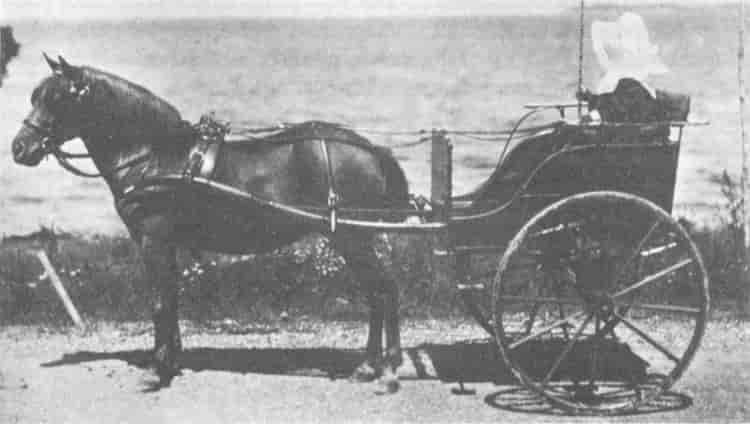
[54]

KENTUCKY BREAKING CART
Body painted red. Trimmed with brown leather.
Not a carriage in the true meaning of the word, this type of vehicle was intended solely for breaking horses. The very long shafts kept the float body and its occupant at a comfortable distance from the heels of the young horse being schooled, and because of the placement of the seat, the driver was given better control and greater security. This cart could also be used for exercising horses.
Manufactured by the H. H. Babcock Company of Watertown, New York.
Gift of Dr. Stuart Orton, Rahway, New Jersey.
[55]
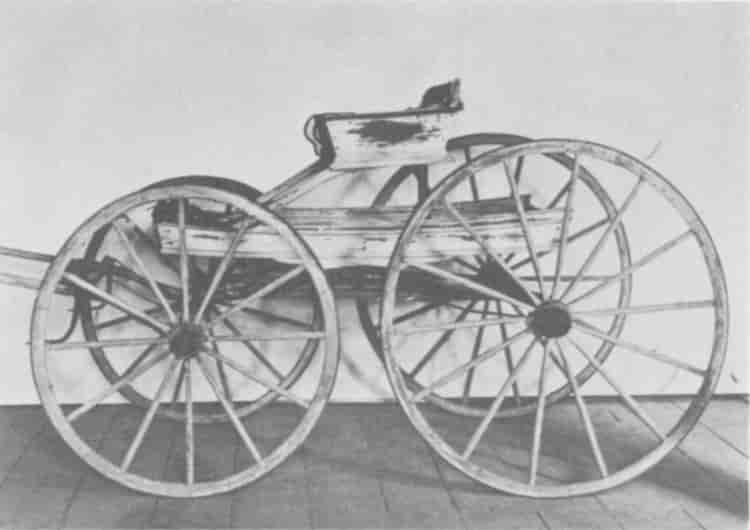
CONCORD WAGON
Body originally painted old blue color.
The concord wagon was the name given to this type of vehicle, although companies other than the Concord, New Hampshire firm of Downing and Abbot manufactured them. In 1813 Lewis Downing started building vehicles in Concord. He formed a partnership with Stephen Abbot, which was later dissolved. Abbot continued manufacturing vehicles and later a new company, Abbot-Downing Company of Concord, New Hampshire was formed. Stage coaches, mountain wagons, horse-drawn barges, even horse-drawn street railway cars were manufactured at the Abbot-Downing shops over the years.
Gift of Mr. W. B. Hill, Tilton, New Hampshire
[56]

PLEASURE WAGON
Green, red wheels, picked out with black.
This vehicle, with its light green acorn stencilled pattern, is one of the oldest carriages in this collection. It was licensed in 1815 in Vergennes, Vermont by Beldon Seymour. It is of hand construction and follows the principles of early framing with the use of mortising and pegging the parts together.
This carriage transported President James Monroe during his tour of the Northern States in July of 1817, and Commodore MacDonough of Lake Champlain fame was also a passenger in this vehicle that year.
In 1888 Mr. Sheldon of Middlebury purchased this wagon from a Mr. Kellogg for $45 and presented it to the Sheldon Museum.
On loan from the Sheldon Museum, Middlebury, Vermont.
[57]
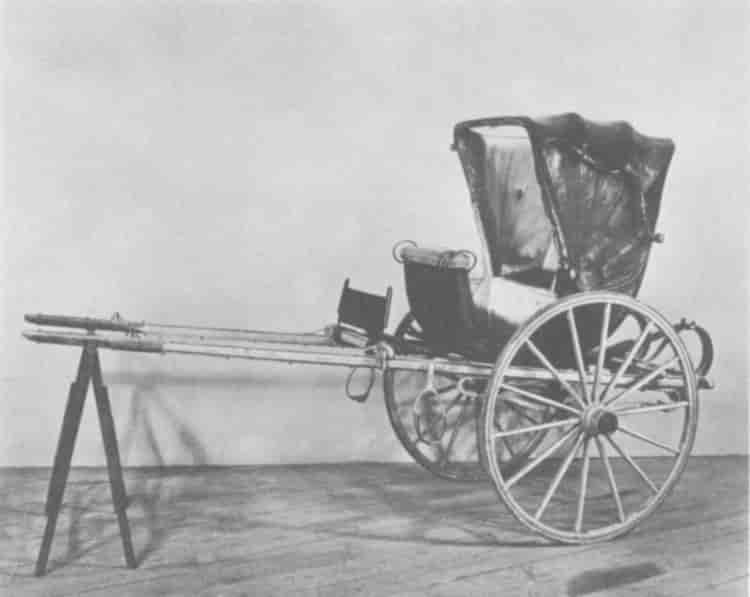
CANADIAN CALÈCHE
Body painted black; red and yellow striping; light grey wheels. Trimming: beige broadcloth with beige lace.
The Canadian calèche differs greatly from the French calèche, which is a four-wheeled vehicle. The body of this two-wheeled Canadian example rests upon leather braces which are suspended from C-shaped supports.
This vehicle displays an extensive use of striping for decoration, but in a restrained manner. “The variety of styles in striping are limited,” said I. D. Ware in his instructions to carriage painters in 1875, “When we discard those which lessen rather than increase the beauty of the work. We first had the fine line enlivened by being dotted at the ends of each stripe ... gradually changes took place in the quantity of striping run on as the desire arose for gaudy colors. Modest and retiring colors were in great measure abandoned, ushering in straw, orange, red and crimson and these were followed and accompanied with a perfect shower of gold leaf.”
[58]

MOUNTAIN WAGON
Body painted very dark green, striped in red; gear black. Trimmed in black leather.
This mountain wagon was originally owned by the Mount Pleasant Hotel up in the Crawford Notch, New Hampshire. At the turn of the century, these elegant resort hotels in the White mountains used these wagons to take their guests to the summit where an elaborate picnic lunch was served to them.
Note the hand brake—it is exceptionally sturdy, for one of these vehicles carrying its full quota of passengers weighed a considerable amount, and checking the rate of descent of the steep mountain roads was somewhat of a problem. This vehicle was built by the Abbot-Downing Company of Concord, New Hampshire.
[59]
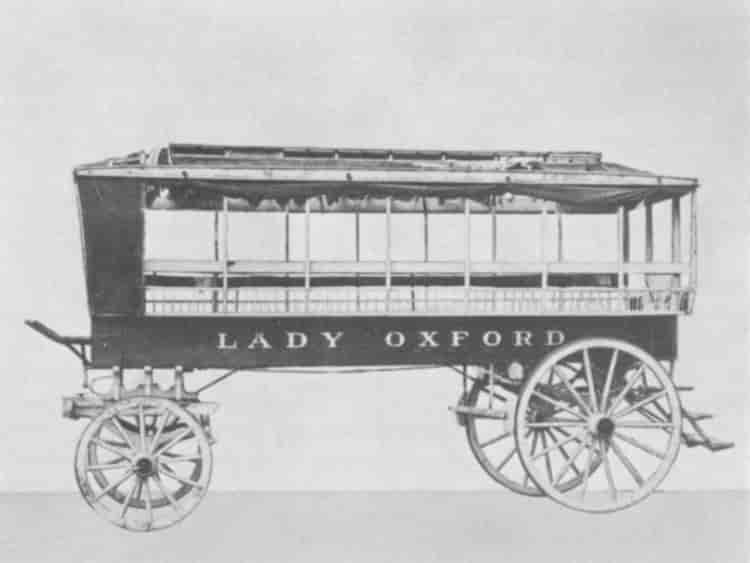
BARGE
Green and yellow body, yellow gear. Lettering Lady Oxford in straw color shadow-outlined in red (recently repainted).
Mr. Jabez W. Peterson, 75 years old in 1954, was the driver of this barge from 1908 to 1918 when it carried passengers to the Brant Rock Beach section from the Marshfield, Massachusetts depot. The barge was built in Concord, New Hampshire by the Abbot-Downing Company and was one of 6 or 8 that regularly plied the beach circuit. Baggage was carried free, and the income from this barge, according to Mr. Peterson amounted to $1,000 in one month at 35¢ fares. Three or four trips were made every day, including Sunday. Sam and John, Genevera and Pete, four sorrel horses with white manes and tails, pulled the Lady Oxford.
“I drove that barge in all the parades,” said Mr. Peterson, “and carried the bands, Grand Army men, etc. All these older men have passed on, and I believe I am the only one left that would remember about that barge.”
[60]

SCHROON LAKE CONCORD COACH
Body painted yellow with orange trim. Interior is russet leather.
The Concord coaches have become a more familiar sight, perhaps, to the youngsters of today than to their parents, for television with its Wild West movies has made the Concord the trademark of the west.
The opening of the gold fields in California—the Comstock Lode, the Nevada silver camps—the famous Wells Fargo saga—all these were made possible because of the Concord coach. The men who drove the coaches and their exploits have become the folklore of America.
Until the completion of the transcontinental railroad, the two choices open to a traveller to the west were the long and arduous voyage by sea around the Cape of Good Hope or the equally dangerous trip by stagecoach over the towering mountains and down precipitous grades. Rigid time schedules were maintained; the six horses used on many of the stages were pushed to their capacity, and the drivers who trekked over the Sierra Nevada made the Placerville grade the busiest thoroughfare west of the Rockies. Dozens of Concord coaches rolled on daily schedules and scaled the heights of 7200 feet as a matter of course.
[61]
The Concord was of the same body form as the oldtime English coaches of the 18th century. The two lengthwise “thorough braces” fashioned of several strips of leather stitched together, absorbed some of the shock. The body hung on these braces with the driver’s seat high in front and an integral part of the coach. Inside there was room for 9 passengers (though often more were crowded in) and the capacity of the coaches was 4,000 lbs. The bodies were rounded and smoothly curved with drop windows and painted decorations of eagles, scrolls and pastoral scenes. Curtains and upholstery were most often of russet leather.
There was another version of the Concord coach—similar in appearance, but specifically designed for the Eastern part of the United States and of lighter construction. These coaches were the connecting links to the railroads until a surprisingly recent time. Such a model is the one illustrated below. It was operated by Waddel & Emerson and ran between the railroad station at Riverside, New York, and the steamboat landing on Schroon Lake, near Pottersville. From there, passengers took the steamer Evelyn to the village of Schroon at the head of the lake or intermediate points.
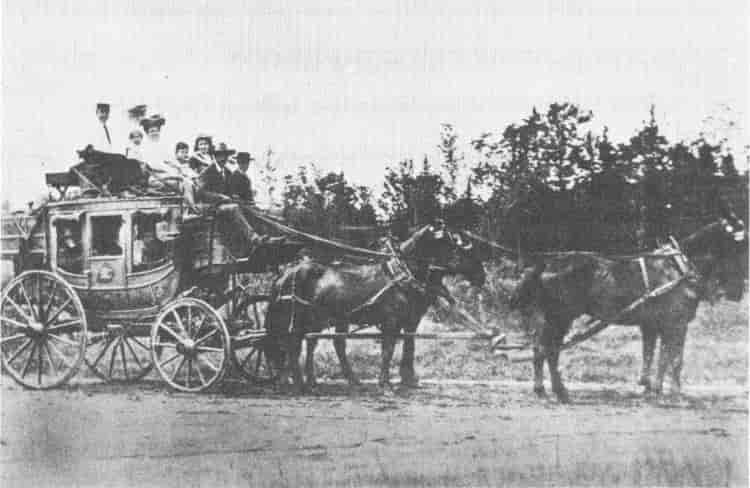
Photo—Gift of Mr. Albert Jacob, Jr. Scarsdale, New York—showing the Schroon Lake coach at intersection of Routes 8 and 9 at Loon Lake in the Town of Chester, Warren County. Photo taken about 1907 or 1908.]
[62]
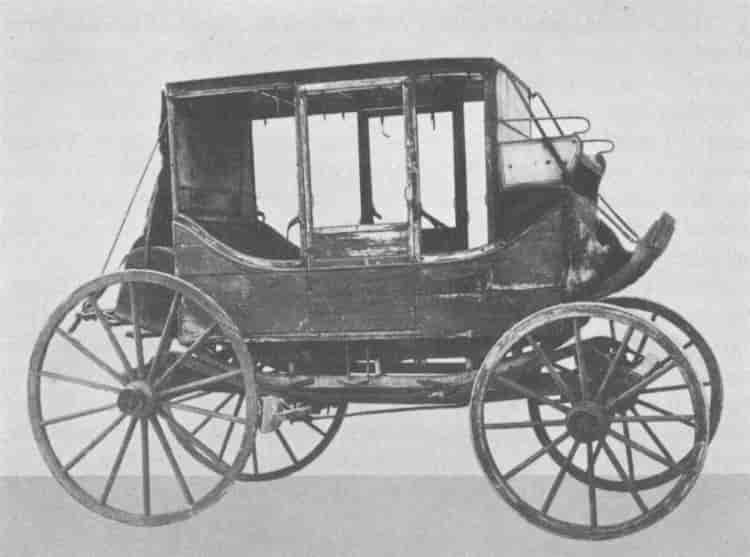
CONCORD MUD WAGON
Body painted Indian red, remnants of yellow paint on gear.
This type Concord, known as the California mud wagon or poor man’s Concord, incorporated the same principles of construction found in the finer Concords, but the joinery was done in a simpler manner and the body was shaped with flat sides instead of the egg shape of the regular Concords.
This mud wagon was used in Herkimer County, New York and was probably built by Abbot and Downing, for it is identical with their style number 208.
[63]
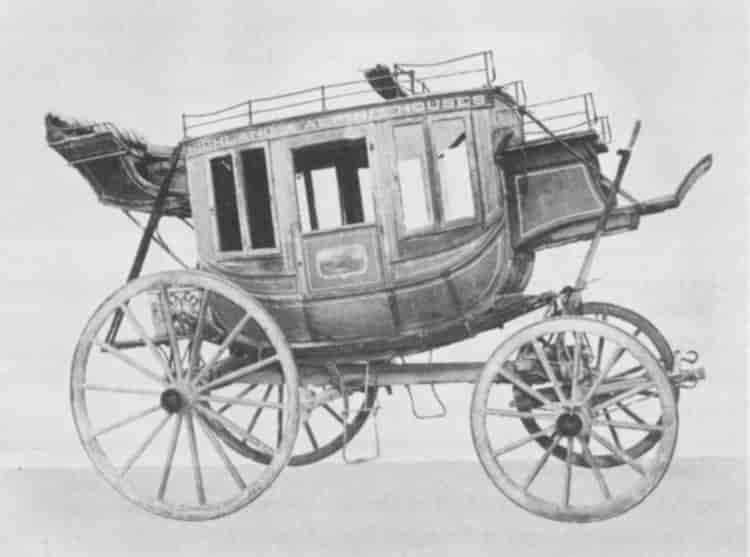
HIGHLAND & ALPINE HOUSE CONCORD COACH
Red with gold and black trim; interior is heavy crimson mohair.
This coach, completed April 5, 1852, was used by the Highland and Alpine hotels in the White Mountains of New Hampshire.
In blurred pencil markings on the inside door where the lining has fallen away can still be seen the names of the men who worked on this coach—John L. French, wheelwright; William L. Pearson, trimmer; John Bergum, painter.
Great care was lavished on the painting of the scrolls, striping and decorative scenes on the door panels. Customers usually had definite ideas as to what they wanted—“ornament up rich and tasty,” “flowers and nice landscapes on doors;” “put eagle,” “on the other door a female figure,” “on the door Pharaoh’s horses,” “a lady on horseback;” “Queen Victoria” (this for a stage line in Nova Scotia, Canada); “a coach and horses painted in the road,” “horses on one door and dogs on the other”—These specifications appear on the old order forms in the archives of the New Hampshire Historical Society.
[64]
Bibliography
Adams, William Bridges, English Pleasure Carriages, London, England 1837
Beaufort, Duke of, Driving, Badminton Series, London, England 1889
Belloc, Hilaire, Highway and its Vehicles, London, England 1926
Burgess, James W., Practical Treatise on Coach Building, London, England 1881
Downing, Paul H., Carriage Gallery at the New York Historical Society, New York Historical Society Quarterly, October 1950
Earle, Alice Morse, Stage Coach and Tavern Days, New York 1900
Felton, William, A Treatise on Carriages, London, England 1796
Fitzgerald, Wm. N., Carriage Trimmers’ Manual and Guide Book and Illustrated Technical Dictionary, New York 1881
Garland, James A., The Private Stable, Boston, Massachusetts 1903
Gilbey, Sir Walter, Modern Carriages, London, England 1905
Howlett, E., Driving Lessons, New York 1894
Hunt, Elmer Munson, Abbot-Downing and the Concord Coach, Historical New Hampshire Quarterly 1945
Knight, Capt. C. Morley, Hints on Driving, London, England 1895
Lene, La Sellerie Français et Étrangère, Paris, France 1878
McCausland, Hugh, The English Carriage, London, England 1948
Mitchell, Edwin Valentine, Horse and Buggy Age in New England, New York 1937
Mosemans’, Illustrated Guide for Purchasers of Horse Furnishing Goods, etc. New York, no date—about 1890
Rittenhouse, Jack D., American Horse-drawn Vehicles, Los Angeles, Calif. 1948
Rogers, Fairman, A Manual of Coaching, Philadelphia, Pa. 1900
Throm, Edward L., Popular Mechanics Picture History of American Transportation, New York 1952
Underhill, Francis T., Driving for Pleasure, New York 1896
Wall, Margaret V., Carriage House of the Suffolk Museum at Stony Brook, Long Island, New York 1954
Ware, Francis M., Driving, New York 1903
Ware, I. D., Coach-makers’ Illustrated Handbook, Philadelphia, Pa. 1875
Secondary sources—pamphlets, newspaper clippings, correspondence, and carriage maker’s catalogs.
[65]

Catalog of Vehicles at Shelburne Museum
Note—Sleighs, commercial and farm wagons, miniatures, and fire equipment will be included in subsequent publications.
| CATALOG NUMBER |
ILLUSTRATED ON PAGE |
|
|---|---|---|
| V-1 | Road Cart (about 1870) | |
| Museum collection | ||
| V-2 | One-Horse Chaise (about 1830) | |
| Built by Coach and Chaise Manufacturer, Charlestown, Massachusetts. | ||
| On loan, Sheldon Museum, Middlebury, Vermont | ||
| V-3 | Chaise (late 18th century) | 9 |
| Museum collection | ||
| V-4 | Doctor’s Gig (about 1800) | 10 |
| On loan, Sheldon Museum, Middlebury, Vermont | ||
| V-5 | Canadian Calèche (about 1885) | 57 |
| Museum collection | ||
| V-6 | Doctor’s Gig (early 19th century) | |
| Museum collection | ||
| V-7 | Curtain Rockaway (early 19th century) | |
| On loan, Sheldon Museum, Middlebury, Vermont; gift to them by C. Bullard of New Haven, Vermont | ||
| V-8 | Pleasure Wagon “President’s Carriage” (early 19th century) | 56 |
| On loan, Sheldon Museum, Middlebury, Vermont | ||
| V-9 | Irish Jaunting Car (about 1900) | |
| Gift of Mr. Cleveland Dodge, New York, New York | ||
| V-10 | Panel-Boot Victoria (about 1895) | 19 |
| Built by Henry Hooker & Company, New Haven, Connecticut (#1400). | ||
| Gift of Mrs. Charles E. Tilton, Tilton, New Hampshire | [66] | |
| V-11 | Octagon Front Rockaway (about 1890) | |
| Museum collection | ||
| V-12 | “Wicker-Seat” Cabriolet (about 1865) | |
| Museum collection | ||
| V-13 | Ladies’ Driving Phaeton—parasol top (about 1890) | |
| Museum collection | ||
| V-14 | Cut-under Phaeton (about 1890) | 3 |
| Museum collection | ||
| V-15 | Curricle (about 1900) | 8 |
| Built by Brewster & Co., New York. Museum collection | ||
| V-16 | Meadowbrook Cart (about 1900) | |
| Museum collection | ||
| V-17 | Three-seat Surrey (about 1900) | 40 |
| Museum collection | ||
| V-18 | Dog Cart (about 1890) | 11 |
| Built by Fred F. French and Company, Sudbury Street, Boston, Mass. | ||
| Gift of Mr. Arthur Brown, Tilton, New Hampshire | ||
| V-19 | Cut-under Basket Phaeton (about 1900) | 6 |
| Gift of Mr. Arthur Brown, Tilton, New Hampshire | ||
| V-20 | Pony Buckboard (about 1895) | |
| Built by Joubert & White, Glens Falls, New York. | ||
| Gift of Mr. J. Watson Webb, Shelburne, Vt. | ||
| V-21 | Extension Top Surrey (about 1900) | 41 |
| Built by J. R. and J. H. Lockwood, Burlington, Vt. | ||
| Museum collection | ||
| V-22 | Coupé Rockaway (about 1900) | 43 |
| Built by Z. Thompson & Bros., Portland, Maine and Kimball Brothers Company, Boston, Mass. | ||
| Museum collection | ||
| V-23 | Stick-seat Surrey (about 1900) | |
| Sold by Walter B. Johnson, Essex Junction, Vermont; built by Cortland Cart and Carriage Company, Sidney, New York. | ||
| Gift of Mrs. Edward H. Loomis, Addison, Vermont. | ||
| V-24 | Leather Top Surrey (about 1900) | |
| Museum collection | ||
| V-25 | Rockaway (about 1885) | |
| Built by Sargent and Company, Boston, Mass. | ||
| Gift of Fanny Allen Hospital, Burlington, Vermont | ||
| V-26 | Miniature Brougham (about 1885) | |
| Gift of Fanny Allen Hospital, Burlington, Vt. | [67] | |
| V-27 | Stick-seat Buckboard, “Liar’s Wagon” (about 1885) | |
| Museum collection | ||
| V-28 | Governess Cart (about 1900) | |
| Gift of Mrs. Wilfred Rhodes, St. Thomas, Jamaica | ||
| V-29 | Concord Wagon (about 1840) | 55 |
| Built by Downing & Abbot., Concord, New Hampshire. | ||
| Gift of Mr. W. B. Hill, Tilton, New Hampshire | ||
| V-30 | Skeleton Wagon (about 1870) | 51 |
| Museum collection | ||
| V-31 | Hansom Cab (about 1895) | 31 |
| Built by Hincks & Johnson, Bridgeport, Conn. | ||
| Museum collection | ||
| V-32 | Kentucky Breaking Cart (about 1895) | 54 |
| Built by H. H. Babcock Company, Watertown, N. Y. | ||
| Gift of Dr. Stuart Orton, Rahway, New Jersey | ||
| V-33 | Depot Wagon (about 1890) | 42 |
| Built by Horace Ervien, Ogontz, Pennsylvania. | ||
| Gift of Mr. and Mrs. J. W. Lippincott, Jenkintown, Pa. | ||
| V-34 | Sicilian Donkey Cart (about 1932) | |
| Built Fabrica Carri, Montoleone, Palermo, Sicily. | ||
| Gift of Mrs. Gambrill in memory of her husband, Mr. Richard V. N. Gambrill, Peapack, New Jersey | ||
| V-35 | Pony Break (about 1938) | |
| Built by Dennis Brothers, London, England. | ||
| Gift of Mrs. Gambrill in memory of her husband, Mr. Richard V. N. Gambrill, Peapack, New Jersey | ||
| V-36 | Pony Dog Cart “Going-to-Cover Cart” (about 1890) | 14 |
| Built by Brewster & Co., New York. | ||
| Gift of Mrs. Gambrill in memory of her husband, Mr. Richard V. N. Gambrill, Peapack, New Jersey | ||
| V-37 | Spider Phaeton (about 1890) | 2 |
| Built by Muhlbacher, Paris, France. | ||
| Gift of Mrs. Gambrill in memory of her husband, Mr. Richard V. N. Gambrill, Peapack, New Jersey | ||
| V-38 | Runabout (about 1900) | |
| Gift of Mrs. Gambrill in memory of her husband, Mr. Richard V. N. Gambrill, Peapack, New Jersey | ||
| V-39 | Buckboard Buggy (about 1900) | |
| Gift of Mrs. Gambrill in memory of her husband, Mr. Richard V. N. Gambrill, Peapack, New Jersey | ||
| V-40 | Buckboard (about 1885). | |
| Gift of Mr. Scott Lord Smith, Poughkeepsie, N. Y. | [68] | |
| V-41 | Tub Cart (about 1883) | 52 |
| Gift of the Webb family in memory of Dr. and Mrs. W. Seward Webb | ||
| V-42 | Pony Buckboard (about 1890) | 46 |
| Built by J. B. Dubuc, Shelburne, Vermont. | ||
| Gift of the Webb family in memory of Dr. and Mrs. W. Seward Webb | ||
| V-43 | Pony Buckboard (about 1900) | |
| Built by Joubert & White (#1202) Glens Falls, N. Y. | ||
| Gift of the Webb family in memory of Dr. and Mrs. W. Seward Webb | ||
| V-44 | Buckboard Phaeton (about 1895) | 45 |
| Built by Joubert & White, Glens Falls, N. Y. | ||
| Gift of the Webb family in memory of Dr. and Mrs. W. Seward Webb | ||
| V-45 | Buckboard with Rumble Seat (about 1900) | |
| Built by Joubert & White, Glens Falls, N. Y. | ||
| Gift of the Webb family in memory of Dr. and Mrs. W. Seward Webb | ||
| V-46 | Mail Phaeton (about 1882) | 1 |
| Built by F. S. Brown & Company, New York. | ||
| Gift of the Webb family in memory of Dr. and Mrs. W. Seward Webb | ||
| V-47 | Skeleton-Boot Victoria (about 1904) | 20 |
| Built by Brewster & Co., New York. | ||
| Gift of the Webb family in memory of Dr. and Mrs. W. Seward Webb | ||
| V-48 | Berlin (about 1890) | 26 |
| Built by Million et Guiet, Paris, France. | ||
| Gift of the Webb family in memory of Dr. and Mrs. W. Seward Webb | ||
| V-49 | Tandem Cart (about 1890) | 12 |
| Gift of the Webb family in memory of Dr. and Mrs. W. Seward Webb | ||
| V-50 | Break with Perch—Wagonette Break (about 1895) | 38 |
| Built by Brewster & Co., New York. | ||
| Gift of the Webb family in memory of Dr. and Mrs. W. Seward Webb | ||
| V-51 | Calèche (about 1890) | 24 |
| Built by Million et Guiet, Paris, France. | ||
| Gift of the Webb family in memory of Dr. and Mrs. W. Seward Webb | ||
| V-52 | Private Omnibus (about 1890) | 23 |
| Built by Brewster & Co., New York. | ||
| Gift of the Webb family in memory of Dr. and Mrs. W. Seward Webb | ||
| V-53 | Brougham (about 1890) | 16 |
| Built by Brewster & Co., New York. | ||
| Gift of the Webb family in memory of Dr. and Mrs. W. Seward Webb | ||
| V-54 | 6-Passenger Rockaway (about 1850) | 44 |
| Gift of the Webb family in memory of Dr. and Mrs. W. Seward Webb | [69] | |
| V-55 | Vis-à-Vis (about 1890) | 22 |
| Built by Brewster & Co. New York. | ||
| Gift of the Webb family in memory of Dr. and Mrs. W. Seward Webb | ||
| V-56 | George IV Phaeton (about 1882) | 4 |
| Built by Brewster & Co., New York. | ||
| Gift of the Webb family in memory of Dr. and Mrs. W. Seward Webb | ||
| V-57 | Buckboard Surrey (about 1900) | |
| Built by Joubert & White, Glens Falls, N. Y. | ||
| Gift of the Webb family in memory of Dr. and Mrs. W. Seward Webb | ||
| V-58 | Norfolk Shooting Cart (about 1885) | |
| Built by Thorn Patent Norfolk Carriage Works, Norwich, England. | ||
| Gift of the Webb family in memory of Dr. and Mrs. W. Seward Webb | ||
| V-59 | Slat-Side Shooting Cart (about 1895) | 15 |
| Built by Brewster & Co., New York. | ||
| Gift of the Webb family in memory of Dr. and Mrs. W. Seward Webb | ||
| V-60 | Formal Coach (about 1890) | 29 |
| Gift of Henry M. Tuttle Company, Bennington, Vermont, in memory of Mr. Fred Stickles, for many years president of that company | ||
| V-61 | Triple Buckboard (about 1885) | 49 |
| Built in Glens Falls New York for Dr. E. D. Ferguson of Troy, New York. | ||
| Gift of Mr. and Mrs. Charles E. Childs, Manchester, Vermont | ||
| V-62 | Double Buckboard (about 1885) | 48 |
| Gift of Mr. J. Watson Webb, Shelburne, Vt. | ||
| V-63 | Royal Spider (about 1900) | |
| Built by Flandrau & Company, New York. | ||
| Gift of Mr. and Mrs. Gilbert Brewer, Burlington, Vt. | ||
| V-64 | Ladies’ Phaeton (about 1900) | |
| Gift of Mrs. Katherine Thayer Hobson, New York | ||
| V-65 | Calèche D’Enfant (about 1825) | |
| Built in France. | ||
| Museum collection. | ||
| V-66 | Landau (about 1885) | 18 |
| Built by Brewster & Co., New York. | ||
| Gift of Mr. Henry O. Havemeyer, Mahwah, New Jersey | ||
| V-67 | Mountain Wagon (about 1890) | 58 |
| Built by Abbot-Downing Co., Concord, New Hampshire. | ||
| Museum collection | ||
| V-68 | Barge (about 1890) | 59 |
| Built by Abbot-Downing Co., Concord, New Hampshire. | ||
| Museum collection | [70] | |
| V-69 | Bottum Boat Wagon (early 19th century) | |
| Gift of Mrs. Carroll Landon, New Haven, Vermont | ||
| V-70 | Tunbridge Pleasure Wagon (early 19th century) | |
| Museum collection | ||
| V-71 | Abbott Pleasure Wagon (early 19th century) | |
| Museum collection | ||
| V-72 | Top Buggy (about 1885) | |
| Museum collection | ||
| V-73 | Dickerman Family Wagon (early 19th century) | |
| Museum collection | ||
| V-74 | Pleasure Wagon (early 19th century) | |
| Museum collection | ||
| V-75 | Convertible Carriage/Wagon (about 1910) | |
| Patented “High Point Wagon” built by Briggs Carriages, Amesbury, Massachusetts. | ||
| Gift of Mr. and Mrs. Gilbert Brewer, Burlington, Vermont | ||
| V-76 | Coach (about 1850) | 28 |
| Museum collection | ||
| V-77 | Roof-Seat Break (about 1900) | |
| Built by Barker & Company, London, England. | ||
| Museum collection | ||
| V-78 | Miniature Phaeton (about 1875) | 7 |
| Museum collection | ||
| V-79 | Canadian Pleasure Cart (early 19th century) | |
| Museum collection | ||
| V-80 | Empire Calèche D’Enfant (about 1810) | |
| Built in Paris, France. | ||
| Museum collection | ||
| V-81 | Racing Sulky (about 1870) | 50 |
| Museum collection | ||
| V-82 | Skeleton Break (about 1910) | 37 |
| Built by Brewster & Co., New York. | ||
| Gift of Mr. F. Ambrose Clark, Cooperstown, New York | ||
| V-83 | Irish Jaunting Car (about 1900) | 30 |
| Built In Dublin, Ireland. | ||
| Gift of Mr. Charles Sumner Bird, East Walpole, Massachusetts | ||
| V-84 | Viennese Wagon (about 1898) | |
| Built in Vienna, Austria. | ||
| Gift of Mr. Charles Sumner Bird, East Walpole, Massachusetts | [71] | |
| V-85 | Breaking Cart (about 1900) | |
| Gift of Mr. Charles Sumner Bird, East Walpole, Mass. | ||
| V-86 | Racing Sulky (about 1870) | |
| Museum collection | ||
| V-87 | Doctor’s Buggy (about 1900) | |
| Gift of Mr. and Mrs. Charles Cross, Burlington, Vt. | ||
| V-88 | Top Buggy (about 1900) | |
| Built by Brewster & Co., New York. | ||
| Gift of Mr. Arthur S. Lawrence, Locust Valley, New York | ||
| V-89 | Buggy (about 1870) | |
| Gift of Mrs. Robert H. Young, S. Starksboro, Vermont | ||
| C-1 | “Liberty” Road Coach (about 1900) | 32 |
| Built by Million et Guiet, Paris, France. | ||
| Gift of Mr. J. Ford Johnson, New York, N. Y. | ||
| C-2 | Highland & Alpine House Concord Coach (about 1852) | 63 |
| Built by Abbot-Downing Co., Concord, New Hampshire. | ||
| Museum collection | ||
| C-3 | Mud Wagon (about 1875) | 62 |
| Museum collection | ||
| C-4 | Park Drag (about 1890) | 34 |
| Built by Brewster & Co., New York. | ||
| Gift of the Webb family in memory of Dr. and Mrs. W. Seward Webb | ||
| C-5 | Schroon Lake Concord Coach (about 1875) | 60 |
| Museum collection | ||
| C-6 | “Defiance” Road Coach (about 1900) | 36 |
| Built by Brewster & Co., New York. | ||
| Gift of Mrs. Gambrill in memory of her husband, Mr. Richard V. N. Gambrill, Peapack, New Jersey | ||
| C-7 | Pony Road Coach (about 1900) | |
| Built by Guiet of Paris, France. | ||
| Gift of Mrs. Gambrill in memory of her husband, Mr. Richard V. N. Gambrill, Peapack, N. J. |

